- All Articles
- Let's Connect
- Fundamentals
- Soft Skills
- Side Projects

A Guide to Problem-Solving for Software Developers with Examples
If I ask you, out of the blue, what’s the role of a developer, what would you answer? Coding all day? Drinking coffee? Complaining about the management?
To me, a developer is first and foremost a problem solver, simply because solving problem is the most important (and the most difficult) part of our job. After all, even if our code is perfect, clear, performing great, a masterpiece of form and meaning, it’s useless if it doesn’t solve the problem it was meant to solve.
So, let’s dive into problem-solving today. More specifically, we’ll see in this article:
- How to define a problem, and the difference sometimes made between problem-solving and decision-making.
- Why some problems should not be solved.
- The two wide categories of problems you can encounter.
- Why it’s important to correctly define the problem, and how to do so.
- How to explore the solution space.
- Why deferring a problem might be the best decision to make in specific situations.
- Why reflecting on the whole process afterward can help you in the future.
This article is mostly based on my own experience, even if I apply here some ideas I found in books and papers.
We have our plan. Now, it’s time to dive deep into the difficult, but rewarding, process of problem-solving.
Problem-Solving and Decision-Making
“When I use a word,” Humpty Dumpty said in rather a scornful tone, “it means just what I choose it to mean — neither more nor less.” “The question is,” said Alice, “whether you can make words mean so many different things.” “The question is,” said Humpty Dumpty, “which is to be master — that’s all.” Lewis Caroll Source
Words are ambiguous; they can mean different things for each of us. So let’s first begin to agree on the definition of “problem-solving” here, to be sure we’re on the same page.
Let’s first look at the definition of the word “problem” in a dictionary:
- According to the American Heritage Dictionary , a problem is “a question to be considered, solved, or answered”.
- According to the Oxford Learner’s dictionary , a problem is “a thing that is difficult to deal with or to understand”.
In short, in any problem, there is some degree of uncertainty. If you’re certain of the solution, the problem is already solved. Nothing would need to be “considered, solved, or answered”.
Information is useful to reduce this uncertainty. The quantity is often not the most important, but the quality will be decisive. If I tell you that 90% of my readers are extremely intelligent, would it help you to solve a problem in your daily job? I bet it wouldn’t. It’s information nonetheless, but its usefulness for you is close to zero.
This is an extreme example, but it highlights an important point: before collecting any data, define your problem clearly; then, according to the problem, decide what data you need. Yet, many companies out there begin to collect the data and then decide what problem to solve. We’ll come back to that soon in this article.
So, to summarize, a problem is a situation with some degree of uncertainty. Sometimes, this uncertainty needs to be reduced to come up with an appropriate solution, or, at least, a decision to move forward to your specific goal.
Is there a Problem to Solve?
Whenever you (or somebody else) see a problem, you should always ask yourself this simple question first: is it really a problem, and should we solve it now ?
In other words, ask yourself the following questions:
- Why is this problem important to solve?
- Would be solving the problem creates some value? What value?
- What would happen if the problem was not solved?
- What desired outcome do we expect by solving the problem?
If the problem doesn’t bother anybody and solving it doesn’t create any value, why allocating effort and time to solve it?
It sounds obvious, but it’s an important point nonetheless. More often than not, I see developers heading first in solving problems without asking themselves if they should solve them at the first place.
The most common examples I can think of are useless refactoring. I saw developers refactoring parts of codebases which never change, or is rarely executed at runtime. In the mind of the developer, the code itself is the problem: refactoring is the solution.
I remember a similar case: a developer refactored part of the codebase which was basically never used. We discovered, months later, when we had more and more users using this specific part of the codebase, that the refactoring didn’t really simplify anything. To the contrary; we had to refactor the code again. The first refactoring tried to solve a problem which didn’t exists.
Of course, the developer could argue that the value created is a “cleaner” codebase, but it’s arguable, especially when the code is neither often modified nor used. The value created here is not clear, and it would have been easier if the first refactoring never happened. In this specific situation, I recommend refactoring when you actively change part of the codebase for another reason (implementing a new feature for example).
Whether a problem is worthy to be solved is subjective. It also depends on the problem: if the solution is clear and straightforward, it might be useful to solve it, if the consequences of the solution are also clearly known and the risks are low. Unfortunately, these kinds of problems, in practice, are quite rare.
Types of Problems
I would define here two wide categories of problems: the problems with a (or multiple) clear solution (what the literature call “problem-solving”), and the problems without clear solution (it’s sometimes called “decision-making” instead of “problem-solving”).
In fact, if the problem you’re trying to solve has a clear, accepted answer, it’s very likely it has been solved already. It’s often the case for mechanical, technical problems. For example, let’s say that you need to order a list; you just have to search on the wild Internet how to do so in your programming language of choice, and you’re done! You can ask an “AI” too, or stack overflow, or whatever.
In my experience, most technical problems have one (or multiple) accepted solution. I won’t speak about these kinds of problems at length in this article, since they’re the easiest to solve.
When you’re in front of a problem which has no clear solution (even after doing some research), it’s where things get more complicated. I’d argue that most problems you’ll face, as a software developer, are of this category. Problems which are directly linked to the domain of the company you work with are often specific (because they depend on the domain), and complex.
For example, I’m working for a company providing a learning platform for medical students who want to become doctors, among other services. This context is changing because the real world is changing; medicine is no exception.
Recently, we had to create new data structures for the knowledge we provide; these data structures are directly linked to the domain (medicine) here. But what data structures to create? How can they adapt to the ever-changing environment? How to capture the data in the most meaningful way, with understandable naming for other developers?
Decisions had to be made, and when there are no clear solutions, you need to come up with a couple of hypothesizes. They won’t feel necessary like solutions , but rather decisions to take to move forward toward the desired outcome. It often ends up in compromises, especially if you’re working in a team where the members have different opinions .
Also, architectural decisions have often no clear solutions because they depend, again, on the changing context. How to be sure that an architectural decision is good today and in three months? How can we make the architecture flexible enough to adapt to the blurry future?
As developers, we deal with complex codebases, which are somewhat linked to the even more complex real world. It’s difficult to know beforehand the consequences of our decisions, as well as the benefits, the drawback, and the potential bugs we introduce.
Before jumping into the solution space however, we first need a good detour in the problem space.
Defining the Problem
Correctly stating the problem.
After determining that we indeed have some kind of problem, it’s tempting to try to find a solution directly. Be patient: it’s better to look at the problem more closely first.
If you don’t specify well the problem, you might not solve it entirely. It’s also possible that you end up solving the wrong problem, or the symptoms of a problem, that is, other minor problems created by a root problem. Often, the ideal scenario is to find the root problem, even if you don’t want to tackle it first. In any case, it’s always useful information.
For example, not long ago, our users didn’t find the content they were searching for, using our search functionality on our learning platform.
We could have directly solved the problem by asking the search team to adjust that for us, but this problem was only a symptom. It wasn’t the first time that we had to spend time and energy trying to communicate to the search team what we wanted to fix; the real root problem here was that we didn’t have any ownership of our search results.
The solution: we created a better API communicating with the search team, to be able to adjust ourselves the search results in a more flexible manner.
When looking at a problem, a good first step is to write it down. Don’t do it once; try to find different formulations for the same problem.
Writing is nice (I love it!), but other ways to represent ideas can be really useful too. You can try to draw what you understand from the problem: a drawing, a diagram, or even a picture can help you understand the problem.
From there, you can ask yourself: do you have enough information to take a decision? The answer will be mostly based on the experience of the problem solver, there is no magical formula to be sure that you can and will solve the problem.
You should also try to look at the problem from different angles, to really frame it correctly. The best way to do so is to solve problems as a team.
Solving Problems in a Team
Trying to describe and think about a problem is a great beginning, but it’s even better if you do it as a team. You can exchange experience, opinions, and it’s easier to look at a problem from multiple angles when multiple developers are involved.
First, make sure that everybody in the team is aware of the problem. Defining it altogether is the best. If you have a doubt that somebody is not on the same page, you can re-explain it using different words. It might bring more insights and ideas to the discussion.
Don’t assume that everybody understands the problem equally. Words are powerful, but they are also ambiguous; never hesitate to ask questions (even if they seem stupid at first), and encourage the team to do the same. If your colleagues see that you’re not afraid to ask, it will give them confidence to do the same.
The ambiguity can also build overtime, after the problem was discussed. That’s why it’s really important to document the whole process, for anybody to be able to look at it again and fix the possible creeping misconceptions. Don’t try to describe everything, but try to be specific enough. It’s a delicate balance, and you’ll get better at it with experience.
If you don’t like writing, I’d recommend you to try anyway: this is a powerful skill which will be useful in many areas of your life.
Regarding the team of problem solvers, diversity is important. Diversity of opinion, experience, background, you name it. The more diverse the opinions and ideas are, the more chances you’ll have to solve the problem satisfyingly (more on that later). If the members of the team have enough respect, humility, and know how to listen to their colleagues , you’re in the perfect environment to solve problems.
As developers, we’re dealing with moving systems, because they need to reflect the ever-changing business domain of the company you’re working with. These problems are unique, and even if similar problems might have been solved in the past, they’re never the exactly same. The differences can have an impact on the solution, sometimes insignificant (allowing you to re-apply the solution found previously), sometimes important enough to change the solution entirely.
Exploring the Solution Space
Now that we’ve defined the problem, thought about it with our team, tried to look at it from different angles, it’s time to try to find solutions, or at least to make a decision.
What is a good decision? The one which will bring you closer to your desired outcome. It sounds obvious, but there can be some ego involved in discussions, which will push us to try to be right even if it’s not the best solution in the current context. Our personal incentives can conflict with the company’s best interest; it’s always good to try to stay aware of that.
The solution should also be the simplest possible, while still moving forward to the desired outcome. It should also have an acceptable level of risk when we decide to apply the solution. In my experience, complicated solutions are the ones which come up first: don’t stop there. Take some time trying to find the best solution with your team.
For example, here’s what we do with my actual team:
- We define the problem altogether.
- We try to think about different hypothesizes. Not only one, but a couple of them.
- We write the benefits and drawbacks of each hypothesis (which can lead to more ideas, and possibly more hypothesizes).
- We commit to a hypothesis, which then needs to be implemented.
What I meant by “hypothesis” here is a solution which might work; but only the implementation of the hypothesis can be considered as a solution. Before the implementation, it’s just an informed guess. Many things can go wrong during an implementation.
This process looks simple, but when you have multiple developers involved, it’s not. Again, if each member of the team have good soft skills and some experience, it can be an enjoyable and rewarding process. But you need a good team for it to work efficiently (that’s why it’s so important to ask the good questions when joining a company). It’s even better if the members of the team are used to swim in uncertainty, and take it as a challenge more than a chore.
The process described above is just an example; in practice it’s often more chaotic. For example, even when a decision is made, your brain might still continue to process the problem passively. If you find some flaws in the hypothesis you’ve committed to, congratulations! You have now a brand-new problem.
I can’t emphasize it enough: try to be as detached as possible from your ideas, opinions, and preferred hypothesizes. The goal is not for you to be right and feel good, but for your company to move in the good direction. It’s hard, but with practice it gets easier.
I also want to underline the importance of finding both benefits and drawbacks for the different hypothesizes you (and your team) came up with.
To find good solutions, we might also need to reduce the uncertainty around their possible consequences. Doing some external research can help, like gathering data around the problem and the possible hypothesizes. In the best case scenario, if you can find enough data, and if you feel confident that you can move forward with a hypothesis, that’s already a great victory.
If you don’t have enough external information to reduce the uncertainty to a level you feel comfortable with, look at your past experience. Try to find problems similar to the one your deal with in the present, and try to think about the solutions applied at the time, to see if they could also be applied in your current case. But be careful with this approach: complex problems are context-sensitive, and the context you were in the past will never be exactly the same as the present and future contexts.
For example, I recently changed the way we display search results in our system, because we had some data indicating that some users had difficulties to find what they really wanted to find. The problem: users have difficulties to find the good information; it’s a recurrent problem which might never be 100% solved. That said, thanks to the data gathered, we found an easy way to improve the situation.
The data was very clear and specific, but it’s not always the case. More often than not, your data won’t really prove anything. It might only show correlations without clear causality. It will be even more true if you begin by gathering data without defining first the problem you try to solve. You can find problems looking at some data, that’s true, but it needs care and deep understanding of what you’re doing; looking at data when you know exactly what you want to solve works better.
Using this kind of process, the hypothesis is often some sort of compromise. That’s fine; committing to a hypothesis is not the end of the process, and there will be other occasions to revisit and refine the solution.
If you don’t feel comfortable with the level of uncertainty of the problem (or the risk involved by applying your hypothesis), you need to dig more. Writing a prototype can be useful for example, if you hesitate between two or more approaches. If your prototype is convincing enough, it can also be useful to gather feedback from your users, even if the ones testing your hypothesis will always be more invested if they test a real-life functionality, instead of a prototype which might use dummy data, or be in a context which is too remote from the “real” context.
In my opinion, prototypes are not always useful for complex problems, because a prototype only test a new feature at time T, but doesn’t allow you to see if the solution stay flexible enough overtime. That’s often a big concern: how will the solution evolve?
But prototyping can still help gather information and reduce the uncertainty of the problem, even if the prototype doesn’t really give you the solution on a silver platter. It’s also great for A/B testing, when you’re in the (likely) case when you have not much information about the real needs of your users. You could ask them of course, but nothing guarantee that they know themselves what these needs are.
If you don’t find any satisfying hypothesis to your problem, you might also challenge the desired outcome. Maybe a similar, simplest hypothesis, with slightly different outcomes, could work better? If it makes things easier, faster, and less complex, it could be the best solution. Don’t hesitate to challenge your stakeholders directly on the desired outcomes.
Deferring the Problem
In some cases, you might be hesitant to try to solve a problem if there is still too much uncertainty around it. In that case, it might be best to defer solving the problem altogether.
Deferring the problem means that you don’t solve it now ; you keep things as they are, until you get more information to reduce the uncertainty enough.
We had a problem in the company I worked with some time ago: we have dosages which can be discovered in articles, but users didn’t really find them, and nobody really knew why. Because of this lack of information, the problem was not tackled right away, but differed. From there, data have been collected overtime, allowing us to understand the scope of the problem better.
Don’t forget that deferring a problem is already taking a decision. It might be the less disruptive decision for the application and its codebase, but it’s s decision nonetheless, and it can have consequences. Seeing a differed problem as a decision will push you to think about the possible consequences of your inaction, and you’ll look at it as a partial “solution”, with some uncertainty and risk associated to it.
In my experience, deferring the problem works well only when you try to actively seek more data to solve it later. It can be some monitoring to see how the problem evolves, or some data taken from users’ actions. Sometimes, simply waiting can also give you important information about the nature of the problem.
What you shouldn’t do is try to forget the problem. It might come back in force to haunt your sleepless nightmares later. Avoiding a problem is not deferring it.
Here’s another example: we began recently to build some CMS tooling for medical editors, for them to write and edit content on our learning platform. We had one GraphQL API endpoint at the beginning, providing data to two different part of the application:
- Our CMS for medical editors.
- Our learning platform for medical students.
We knew that using one single GraphQL endpoint for these two types of users could cause some problems.
But we didn’t do anything about it, mostly because we didn’t see any real, concrete problem, at least at first. When a minor symptom, related to this unique endpoint, popped up, we spoke about it, and we still chose not to do anything. We preferred deferring the problem once more, to try to solve the real problem (one API for two different kinds of applications) later.
Finally, when we had enough symptoms and some frustration, we decided to split our graphQL API in two different endpoints. It was the best moment to do so: we had enough information to come up with a good decision, we applied it, and we stayed vigilant, to see how our applied hypothesis would evolve.
Moving fast and breaking things is not always the best solution. In some situations, waiting a bit and see how things evolve can allow you to solve your problems in a more effective way. But, as always, it depends on the problem, its context, and so on.
Reading this article, you might have wondered: how much information is enough to be comfortable enough to apply a solution? Well, again, your experience will be the best judge here. You’ll also need to consider carefully risks, benefits, and drawbacks. It doesn’t mean that you need to chicken out if you don’t have 100% certainty about a problem and some hypothesizes; being a software developer implies to have some courage and accept that mistakes will be made. It’s not an easy task, and there is no general process to follow in any possible case.
In short: use your brain. Even if you’re totally wrong, you’ll have the opportunity to fix the bad decisions you’ve made before the implementation, during the implementation, and even after it. We don’t code in stone.
The Implementation: The Value of Iteration
You’ve gathered with your team, tried to define the problem, found multiple hypothesizes, and agreed to try one of them. Great! Problem solved.
Not so fast! We still need to apply the hypothesis, and hope that it will become a good solution to the problem. Doing so, you’ll gather more information along the way, which might change your perspective on the problem, on your hypothesizes, and can even create some baby problems on its own.
It’s where the agile methodology is useful: since we’ll never have 100% certainty regarding a problem and its possible solution, we’ll learn more about both while implementing the hypothesis. That’s why it’s so valuable to iterate on the implementation: it gives you more information to possibly adjust your code, or even the problem, or even switching hypothesizes altogether. Who knows? A solution which is not implemented is just a guess.
If the hypothesis applied is not the ones you would have personally preferred (compromising, or even giving up on your preferred solution is common in a team), only applying it will tell you if you’re right or wrong; that is, if the hypothesis can become a solution solving the problem, at least in the present context.
If you’re worried about how a specific solution will evolve overtime, it’s more complicated, because an implementation won’t give you the information you seek. Still, implementing a hypothesis can be a great source of learning (the most valuable to me is when I’m wrong, because I learn even more). If you think that your hypothesis can have better outcome at time T, you might also try to implement it and compare it. Again, it’s where prototyping is useful.
When applying the solution, you need to look at the details of the implementation, as well as the big picture, to judge if the solution you’re creating is appropriate (leading to the desired outcome). This is a difficult exercise. In general, a developer should be able to reason on different levels of abstraction, more or less at the same time. Again, if you’re aware of it, your experience will help you here, and you can also push yourself to think of all the possible risks and consequences at different levels.
If you work in a team, try to participate (at least a bit) into the implementation of the solution. It’s not good to create silos in teams (that is, only a couple of members have some information others don’t have).
You can go as far as looking at other projects, and ask yourselves these questions:
- Did we had similar problems on these other projects? How did we solve them?
- What was the context of these projects? Is it similar to our current context?
- What did we learn from these other problems, and their implementation? Is the implementation similar to what we’re doing now?
In any case, I would definitely recommend you to write a development journal. I write mine for years, and it has been valuable in many cases. I basically write in there:
- The interesting problems I had.
- The decisions made.
- How the implementation of the solution evolved overtime.
- The possible mistakes we made along the way.
It’s a great resource when you have a problem and you want to look at your past experience.
To evaluate your decisions overtime, nothing will beat a good monitoring process: logs, tests, and so on. It’s what the book Building Evolutionary Architecture call “fitness functions” for example, some monitoring allowing you to measure how healthy your architecture stays overtime. It doesn’t have to stop to the architecture; you can think about different monitoring system to see how something evolve, especially if the solution has still a lot of uncertainty regarding its benefits, drawbacks, and risks.
You can also do that retrospectively: looking at how the code complexity evolve overtime using Git for example.
Retrospective on the Process
We defined the problem, implemented a solution iteratively, and now the problem is gone. That’s it! We made it! Are we done now?
Decisions are sometimes not optimal, and implementing a solution successfully doesn’t mean that there wasn’t a better (simpler) one to begin with. That’s why it can be beneficial to look back and understand what went right, and what went wrong. For example, we can ask ourselves these questions:
- Looking at what we learned during the whole process, is there a potentially better hypothesis to solve the problem in a simpler, more robust way?
- What are the benefits and drawbacks we missed when speaking about the different hypothesizes, but we discovered during the implementation? Why we didn’t think about them beforehand?
- What other problems did we encounter during the implementation? Did we solve them? Did we differ some? What should be the next steps regarding these new problems?
- What kind of monitoring did we put in place to make sure that the solution won’t have undesired outcomes overtime? Can we learn something with this data?
Reflecting on past solutions is a difficult thing to do. There is no way to logically assess that the decision taken was better than others, since we didn’t implement the other hypothesizes, and we didn’t look at them overtime to appreciate their consequences. But you can still look at the implementation of the solution overtime, and write in your developer journal each time there is a bug which seems directly related to the solution. Would the bugs be the same if another solution would had been applied?
Bugs are often not an option; they will pop up, eventually. Nonetheless, it’s important to make sure that you can fix them in a reasonable amount of time, and that you don’t see them creeping back in the codebase after being solved. Some metrics, from the DevOps movement (like MTTR for example) can help here. Sometimes, bugs will show you a better, more refined solution to the original problem; after all, bugs can also give you some useful information. They are also the most direct result of the implementation of your solution.
If you want to know more about measuring complexity (which can be also used to measure complexity overtime after applying a solution), I wrote a couple of articles on the subject .
Humility in Problem-Solving
It’s time to do a little summary. What did we see in this article?
- We need to ensure that the problem we found is really a problem we need to solve. Is there any value to solve the problem? Is it even a problem?
- Try to determine what kind of problem you have: a problem which can have multiple, specific, known answers (like a technical problem), or a problem which depends on the real-life context, without known solutions?
- Defining the problem is important. Try to define it using different words. Write these definitions down. Does everybody in your team understand the problem equally?
- It’s time to explore the solution space. Draft a couple of hypothesizes, their benefits, drawbacks, and risks. You can also do some prototyping if you think it would give you more information to take the best decision.
- Do you have enough information to implement a hypothesis, becoming effectively a solution? If it’s not the case, it might be better to keep the status quo and try to solve the problem later, when you’ll have more information. But don’t forget the problem!
- If you decide to implement a solution, do it step by step, especially if you’re unsure about the consequences of your decisions. Implement an independent part of the hypothesis, look at the consequences, adjust if necessary, and re-iterate.
- When the solution is implemented, it’s time to reflect on the whole process: did we solve the problem? What other problems did we encounter? Maybe another solution would have been better? Why?
As I was writing above, most problems you’ll encounter will be complex ones, embedded into a changing environment with different moving parts. As a result, it’s difficult to train to solve problems in a vacuum; the only good training I know is solving real life problems. That’s why your experience is so important.
Experience build your intuition, which in turn increase your expertise.
You’ll never have 100% certainty that a solution will bring you the desired outcome, especially if you are in front of a complex problem with a blurry context. If you are absolutely convinced that you have the good solution without even beginning to implement it, I’d advise you to stay humber in front of the Gods of Complexity, or they will show you how little you know.
- How to solve it
- Hammock Driven Development
- When Deferring Decisions Leads to Better Codebases
- Lean Development - deferring decision

Problem-Solving Skills for Software Developers: Why & How to Improve
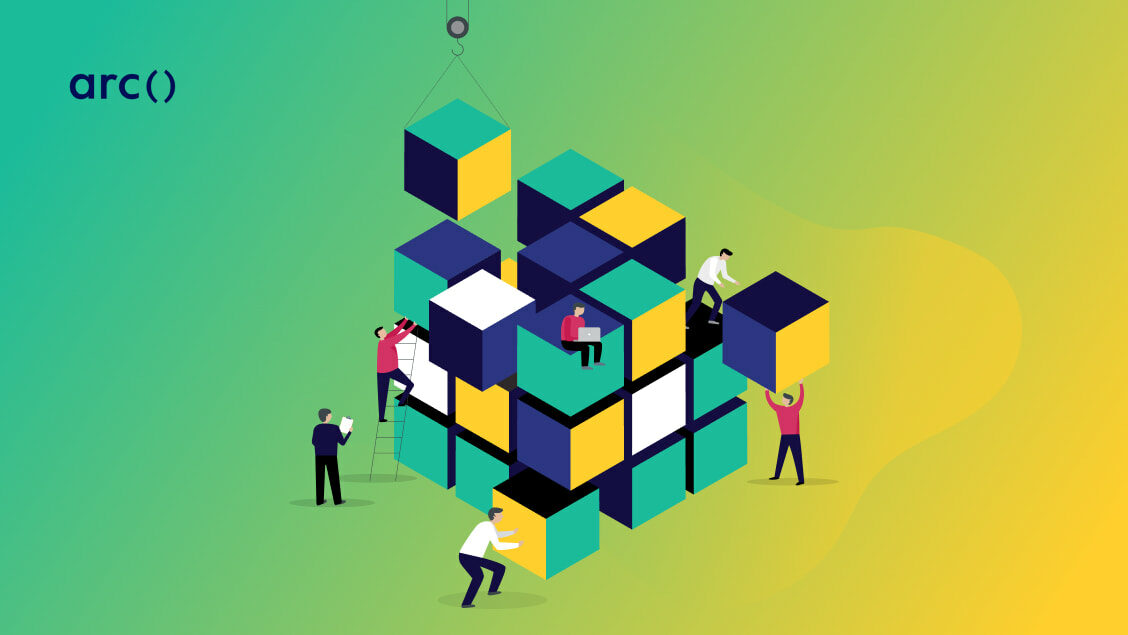
Problem-solving skills go hand-in-hand with software development. Learn some great problem-solving techniques and tips for improvement here!
Software developer jobs today require that you possess excellent problem-solving skills , and for good reason. Unfortunately, there seems to be a sort of talent gap when it comes to this one skill required of all software developers.
Troubleshooting and problem resolution are both informally and formally taught, but you mostly find that software developers have to learn problem-solving skills on their own. This is true for self-taught developers , obviously, but also even for those with software engineering degrees or who’ve graduated from coding boot camps.
This is why it’s necessary to acquaint yourself with the problem-solving process, whether you are a newbie or an experienced developer. In this article, we’ll explore everything you need to know about problem-solving so you can 10x your software development career.

What are Problem-Solving Skills?
As a developer, what do we mean by problem-solving? Let’s attempt a simple definition.
In software development, problem-solving is the process of using theories and research to find solutions to a problem domain, while testing different ideas and applying best practices to achieve a desired result. Problem-solving also has to do with utilizing creativity and logical thought processes to identify problems and resolve them with software.
Becoming a great software developer hinges more on learning algorithms than programming languages or frameworks . And algorithms are simply step-by-step instructions to solve a given problem.
Read More : How to Build a Software Engineer Portfolio (With Examples & Tips)
Why are impeccable problem-solving skills crucial?
Making good use of a computer language can be likened to being a skilled writer. An effective writer must know how to construct sentences and use grammar appropriately. There’s more to writing than just knowing all the words in the dictionary, and that’s how it works for developers, too.
You have different tasks to work on as a software developer, including perhaps designing, coding, and troubleshooting. Much of your time will be spent on identifying problems, spotting and correcting bugs, and making sense of codebases from before you started working there. Being ingenious at problem-solving is essential in creating incredible solutions to issues that arise throughout software development.
To demonstrate ingenuity, let’s consider Google’s autocomplete tool as an example.
The autocomplete tool is built to suggest related terms in the search bar as you type. The idea behind the tool is to reduce more than 200 years of time spent typing daily and to help users save time by up to 25% while typing.
Here’s what had to be done:
- To activate real-time completion of suggestions, the UI experience and JavaScript had to be implemented.
- Next, since users could type just about anything, the autocomplete suggestions had to be compiled into a sensible list dependent on user input.
- Then, Google had to create a back-end sustainability system for this function. Doing this meant massively increasing its infrastructure to accommodate all forms of data query and HTTP requests.
- Finally, the user interface had to be refined by software engineers in order to make sure that every user enjoyed a worthwhile experience. So they employed Google Trends to power the auto-completion tool while using algorithms to take out explicit or offensive predictions in line with Google’s auto-completion policy.
This is just one of Google’s innumerable problem-solving examples, but it’s clear to see that solving problems involves more than just telling a computer to do stuff. It’s about your ability to come up with parameters rightly tailored to target users so they can meet their goals.
So why must developers focus on problem-solving at work?
Software developers work with a wide range of people and departments, and it’s common to discover that some clients and teams find it difficult to define what they want. As a problem solver, it’s up to you to help them identify their needs and communicate their thoughts in an effective way.
Of course, you’ll need time and practice to develop your problem resolution ability. That’s because it’s less about solving problems faster but more about coming up with the best solution . And then you’ll need to deploy that solution.
Read More : Common Interview Questions for Software Developer Jobs (Non-Technical)
Types of problem-solving skills
Now let’s talk about four types of problem-solving skills for developers:
1. Parallel thinking
As a software developer, parallel thinking is a crucial skill necessary to perform optimally. This makes it possible for you to carry out two tasks that complement each other at the same time (like an optimized form of multitasking skills). Being able to reorder tasks to boost parallel execution can help to improve your output and save valuable time .
2. Dissecting broad and/or complex goals
When it comes to building software, you will need to effectively outline the steps and tasks necessary to achieve your goal. Developers must learn to break large and complex tasks into smaller assignments because this is an important skill that will help you create results with precision.
3. Reimplementing existing solutions
You don’t always need to reinvent the wheel. Part of being an effective software developer comes with being able to use already existing tools before even thinking of creating new solutions. Developing problem-solving skills is very much connected to finding solutions that already exist and reusing them.
4. Abstraction
Keep in mind that goals tend to evolve. So if your client comes up with new ideas, that will mean changing your design goals and reordering your tasks. A good programmer must learn to create solutions in such a way that does not require a complete redesign from scratch.
You also have to become adept at abstracting problems so that your solutions can get them resolved so long as they aren’t entirely different from the original issue. You don’t necessarily have to abstract every aspect to avoid more complications being created. This calls for balance by abstracting only where necessary without making narrow decisions.
Read More : Learn 8 Great Benefits of Working From Home
4 Important Tips & Strategies for Improving Problem-Solving Skills
To keep your problem-solving skills and techniques from growing weaker over time, you need to exercise them non-stop. As they say: practice makes perfect!
To train the problem-solving side of your brain, these four tips and strategies can help you improve your abilities:
1. Make problem-solving a part of your life
Never restrict yourself to working on problems only during work hours. Don’t make it a chore, but, instead, do things that make problem-solving look fun. The game of chess, solving puzzles, and playing video games that compel you to think critically will help strengthen your problem-solving skills, and you can tell your significant other you are advancing your career! 🙂
When you come to a complex problem in your life, whether it’s budgeting for a home or renovating the downstairs bathroom, approach it both creatively and critically. Ask yourself: What would a great software engineer do in this situation?
2. Use different platforms to solve problems
Proffer solutions to a set of problems without restricting yourself to one platform. Using different platforms and tools regularly helps make sure you become flexible as a problem-solver. And it makes sense, because there really is no universal solution for the different problems that pop up in your line of work. Trying out different platforms to solve different problems helps you to keep an open mind and enables you to test out different techniques when looking to find solutions.
Read More : 12 Common Mistakes Keeping You From Landing Your First Developer Job

3. Be open to assistance from external sources
Part of being a good software developer comes with being able to ask for help and also accept all forms of feedback. You might need a different opinion or a new set of eyes to help find the most fitting solution to some problems. It makes sense to view building problem-solving skills as more of a team effort rather than a personal journey.
Have an open mind and heart to function not only as an individual but also as a collective. It’s a utopian working environment where everyone supports each other to become better versions of themselves. So if you come across an issue that keeps you stuck, get help! You may find someone who has a more refined framework or method you never knew existed or would have thought of using. You could then learn from them and add their solution to your toolkit.
Get feedback often, as well. This could be the catalyst to making improvements to your processes and evolving them into something truly refined.
4. Tackle new problems using lessons from past solutions
As you practice and finesse your ability to identify problems and find solutions, you’ll begin to notice patterns. It’s more like developing your toolbox armed with a wide range of solutions that have proved useful in the past. So when problems emerge, you will notice how easy it is to take some of those old solutions and apply them to the new problem.
The more you attempt to apply creativity in solving problems, the more you grow your skills. In the long run, that will help you find the right solutions faster and apply them to a wide range of problems more naturally. It’s all about improving the effectiveness and efficiency with which you tackle new problems while applying only the best possible solutions.
Read More : How to Stay Motivated at Work
3 Complementary Skills to Improve to Become a Good Problem Solver
Developing software is mostly about problem-solving at the very core before even writing your first lines of code. You have to identify problems that can be solved using software. Then you have to go on to understand how people try to solve such problems in real life.
It’s up to you to come up with a framework that allows you to take both the problem and the solution and convert them into computer code. And you have to do this in such a way that makes the software even more efficient and effective than a human.
While going through this process, developers also have to handle other problems such as deadline deliveries, checking for bugs and fixing them, and collaborate across teams. So, supporting skills must not be overlooked.
Software developers must build interpersonal skills and collaboration skills . Being able to empathize, accept feedback, handle criticism, listen intently, and show respect for others are all important characteristics and abilities necessary for teamwork, and, thus, necessary for solving problems on the job.
Read More : 5 Ways to Stand Out & Get Noticed in Your Current Development Job
Communication
No one is an island, and that’s true when you consider how software engineers work. Building software requires keeping up with clients and teammates and other departments. You can’t afford to be a Lone Ranger, at least not 100% of the time, and that’s why employers always look for good communication skills.
Being a good software developer also involves how well you can break down very complex concepts to laypeople. You want to be the kind of person who fixes a problem and is able to explain how you were able to do it. It’s all about your ability to be clear and articulate about every aspect of your work. And you want to be able to communicate not just verbally but also in written form.
To build your communication skills as a developer, you can learn from more experienced people and observe how they interact with their clients. And, don’t forget, with more and more companies becoming global enterprises and going remote, it’s important to brush up on your intercultural communication skills , as well.
Logical thinking
The difference between elite software developers and average ones is often said to be logical thinking. The ability to process thoughts logically is important, because you’ll often spend most of your time finding and fixing bugs rather than writing code.
Problems can show up from just about anywhere, even from what seems to be the most insignificant errors. So, your ability to detect software issues and solve these problems using deductive thought processes is a vital ingredient to your success as a software developer.
Read More : Questions to Ask at Interviews for Software Engineering Jobs
Problem-Solving Stages & Practices
There are countless problem-solving processes and various schools of thought regarding the best way to approach problems whenever they arise. To solve that problem, we’ve pooled some of these frameworks together to come up with a comprehensive approach to problem-solving.
Step 1 – Define the problem
You have to first start with problem identification. Knowing what you are dealing with is important, because you don’t want to risk spending valuable time applying wrong solutions. Avoid making automatic assumptions. Even when the symptoms look familiar, you want to investigate properly because such signs could be pointing to something else entirely.
Problems in software development come in different sizes and scopes. You could be having trouble getting some aspects of the product to respond in the desired way. Or maybe you’re having issues trying to decipher a codebase section where you can no longer communicate with the original developers. Sometimes, the problem could come in the form of an unfamiliar error message and you’re at loss.
Once you’re able to define the problem, make sure to document it.
Step 2 – Analyze the problem
Now it’s time to carry out problem analysis . Before deciding what problem resolution methods to adopt, it’s necessary to find out all there is to the issue, which builds on our first step. This will make it easier to come up with ideas and solutions later on.
Problem analysis isn’t always a walk in the park. There are times when the problem involves a very small mistake such as failing to import a package correctly or a small syntax error. Other times, however, it could be such a huge error, like the entire program acting differently than what you want. There might be no alarms or blinking red lights to tell you what the exact problem is.
If you encounter such situations, you can find answers by articulating the problem. Document what you intend to do, what you’ve done, the original intention for the program, and where you currently are. Communication comes in handy here, of course, not just in your documentation, but also in how you relay it to your teammates.
Read More : Got a Busy Developer Schedule? Here’s How to Keep Learning & Make Time
Step 3 – Brainstorm
This step has to do with generating ideas, and you can benefit from discussing the problem with a team and then coming up with ways to get it fixed. Keep in mind that problem-solving at work involves interacting with a diverse group of people where the individuals have unique skill sets and experiences.
Many developers tend to neglect the previous steps and rush straight into brainstorming. That’s definitely not a good way to go about problem-solving. The idea is not to skip the important steps in the process.
Once you get to the point where ideas need to be generated, do not discard any, because this step relies on a wide range of ideas. Only after gathering as many perspectives as possible should you then begin reviewing and narrowing down to the best possible solution.
Step 4 – Make a decision
At this point, all viable solutions have to be analyzed before selecting the most appropriate one to implement. Picking the best possible solution depends on its ability to meet certain criteria. It must be suitable, feasible, and then acceptable.
What it means is that the solution must be able to get the problem solved. It should also be easy to see how such a solution fits into the equation. And then every member of the team involved in the brainstorming process has to unanimously accept the solution.
Read More : How to Network as a Software Engineer
Step 5 – Implement
After identifying and choosing the solution, the next logical step is to plan out the implementation process and then execute it. Coming up with a detailed plan is crucial if the solution is to be a success.
Now this plan must detail all the necessary steps required to implement the solution. It will also explain the length of time and stages of work required. Once all of that is put in place, you can then move forward with the execution. The idea is not just to execute a solution but to do it the right way.
Implementation using automated tests can help to keep unexpected issues from arising in the future. Some other problem-solving practices or approaches begin the process with this step. So, whenever any changes are made to the project, tests asserting that the changes will perform as required will be written first before the changes are then made.
Step 6 – Evaluate
No problem-solving process can be deemed comprehensive enough if there is no room for evaluation. Whatever the solution may be, it has to undergo strict evaluation in order to see how it performs. That will also help determine whether the problem still exists and the extent to which such an issue keeps recurring.
In the event that the problem persists despite the implementation of a detailed plan, then the developer and team may even have to restart the problem-solving process. However discouraging that may sound, at least you’ll have caught it early enough. And, this also proves the process worked.
Read More : How to Become a Software Engineer: Education, Steps & Tips for Success

Final Thoughts
Developing problem-solving skills is quite necessary for software developers. To be a successful problem solver, you will need lots of years down the line to practice what you study.
Always remember that you are a problem solver first before anything else. There is more to building software than just understanding the tech behind it and writing lines of code. It’s all about improving your ability to identify problems and find solutions, and that will need lots of experience on your part.
Never shy away from problems, but learn to think critically and logically in any situation. By applying the six-step strategy for problem-solving at work discussed in this piece, you will be more equipped to come up with the most effective and efficient solutions.
We hope you enjoyed reading our guide on how to solve a problem as a software developer and ways to improve skills as a problem solver! If you have any questions, feedback, or other great problem-solving techniques or methods, let us know in the comments below 🙂
The Arc team publishes insightful articles and thought leadership pieces related to software engineering careers and remote work. From helping entry-level developers land their first junior role to assisting remote workers struggling with working from home to guiding mid-level programmers as they seek a leadership position, Arc covers it all and more!
Join the discussion Cancel reply
Save my name, email, and website in this browser for the next time I comment.
Further reading
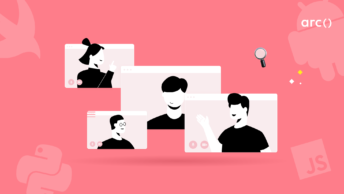
Here Are 43 of the Best Online Developer Communities to Join in 2024

Ready to Take On a Senior Role or Leadership Position as a Developer?

Key Analytical Skills for Developers (& How to Continually Improve Them)
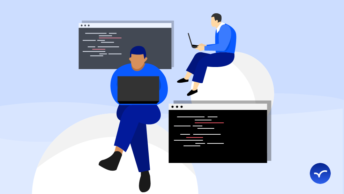
Here’s When You Can TRULY Call Yourself a “Senior” Software Developer
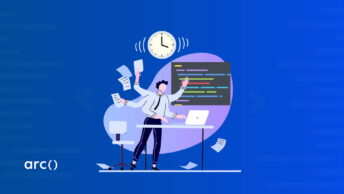
Time Management Skills for Developers: Best Tips, Tools, and Strategies

Software Engineer Degree: Pros, Cons & Alternatives
Common problems in mobile app development and how to solve them

Table of Contents
Home » Blog » Common problems in mobile app development and how to solve them
Our reliance on contemporary apps has helped developers enter lucrative markets, like dating and education. Businesses are also thriving on mobile apps’ convenience, with experts projecting the enterprise mobility market to be worth $510 billion by 2022.
With Japanese brides using wedding planners on apps like Bridestory and the increasing demand for dating apps post-pandemic, mobile developers have endless opportunities.
But does this financial Elysium exempt app creators from potential problems? Or are there battles they must win before releasing mobile apps to the public?
This article discusses some common issues that arise during the stage of mobile app development and how app creators solve them. Also, the reading highlights a few tools developers can use to ensure their mobile apps hit the market without hitches or bugs.
The key people in mobile app development
Developers are not the only ones responsible for an app’s success. It’s primarily a project manager who guides the developer and designer’s processes, ensuring they have all the necessary resources available for work. So when problems plague any process, they act accordingly by delegating tasks and providing the development team with tools to ease their flow.
Brand strategists also contribute to the success of mobile development. They research existing competitors in the market and inform the developers of their findings. During the research, they spotted issues similar apps faced and the audience’s response to them. Then they notify the app creators to avoid mistakes or change the course of action if they’ve already made them.
Top five mobile app development problems and solutions to them
The developers are always in the thick of things. They keep up with the latest trends in the industry, as well as test their product for bugs and common problems, including the following ones:
Not defining the app’s target audience
Many developers jump into creating an app based on a eureka moment without confirming if an audience exists for their product. No matter how bright an app idea is, if there is no need for it in the market, it won’t succeed.
Creating an app that solves a problem people haven’t even recognized is a winning strategy. Yet, drawing the line between an unrecognized need and the one you assume people have is not easy.
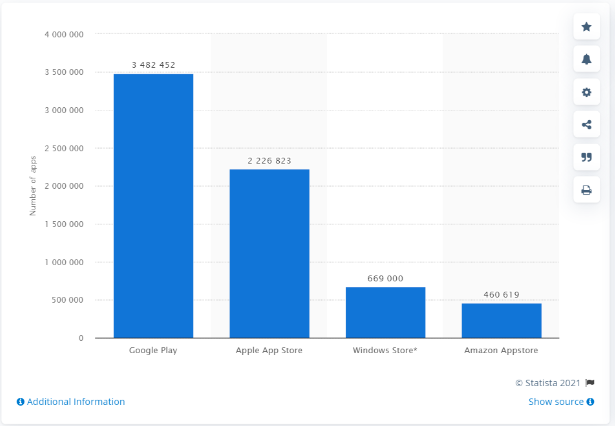
With over 6.5 million apps already available on the app stores, developers need to team up with market researchers and brand strategists to define their product’s niche in the market. They need strategy sessions to visualize the app’s idea and create a portrait of its average user.
Strategizing will help teams know if the demand is high enough for them to generate revenue. It will also ensure their apps won’t be among the 80 – 90% that users abandon after trying out.
Communication breakdown
Communication is an aspect of mobile app development that people often overlook. We see cases where developers don’t obey some of the project owner’s requests because they never got the memo.
The devastating effects of communication breakdown during a mobile app development stage are often not evident until it’s too late. They can extend the app’s release to market and leave stakeholders unsatisfied.
So, developers need to communicate with UX/UI designers, researchers, and managers to avoid losing track of deadlines. They can use communication tools like Slack, Trello, and G-suite to ensure that everyone involved in the development process is up to speed with their roles, deadlines, and sudden changes.
Compatibility problems
There are two major compatibility issues that mobile app developers face. They include:
- Platform compatibility
Developers often struggle with making their apps compatible with different platforms. Android app developers usually use Java, Ruby on Rails, or PHP to develop apps. Meanwhile, iOS app development requires Swift or Objective-C programming languages. So creating apps to integrate with both platforms calls for a skilled developer.
Besides, other mobile operating systems like Huawei’s Harmony OS and Windows Mobile OS can complicate the development process if developers need to make their apps run there. But one can make their apps run on several platforms too, and they can try cross-platform mobile app development frameworks (MADP) for that. This option is cheaper as it ensures native app-like performance and simplifies the job by allowing Flutter developers to write reusable codes.
- Device compatibility
Developers also have to make the app run on many devices and their form factors. For instance, a few years ago, the standard Android device screen had a 16:9 aspect ratio. Today, phone manufacturers produce slimmer, taller phones, making the average aspect ratio 20:9 , as seen in Samsung Galaxy S21 Ultra.
App creators need to stay in the loop with these changes and optimize their apps for multiple modern devices. They can use the responsive and adaptive app design approaches to create flexible apps that adjust to the screen size of the user’s device. These strategies improve the UX factor when running apps on different phones and tablets.
Poor planning and strategy
Many mobile app developers prefer to work in isolation based on their idea. Yet, the serenity of working alone can also leave developers short-sighted. Without strategizing and using frameworks like SWOT analysis, they may end up chasing their tails.

Proper planning will give the app development project a direction and align all the stakeholders with the app’s goals and the brand’s vision. It will also reveal tools needed later, solve naming issues and save resources.
During strategy sessions, teams can create a product roadmap and define the minimum viable product to take to market if they run out of time. They can also decide which features are necessary for their app based on market and design research data. Finally, a project manager can direct the strategy and provide the design and development teams with tools like Sketch to plan the app flow.
App security concerns
In a world where online data theft and privacy issues can lead to legal battles , the last thing any app owner wants is to launch an app with security issues. Still, securing a mobile app is a lot more complicated than many other processes involved in app development.
Developers need to protect the app from malware, bugs and prevent other vulnerabilities. As such, they can solve security problems by encrypting the app’s communication with its server.
Strategies like symmetric cryptography with hard-coded keys and encrypting the database through VPN and SSL work well. The developers can also encrypt local data using Ciphered Local Storage Plugin.
When a developer develops a mobile app then, an SSL certificate is required. To assure end users about code integrity and security, a mobile app should have a cheap code signing certificate that is available from the market. It removes untrusted software warnings.
To keep hackers away, developers also need to protect their app from reverse engineering. For this, they can create app codes that are difficult to understand (obfuscation codes). But this strategy can be problematic for future teams that might need to change the app.
Finally, the team needs to analyze possible threats and test the app’s security to plug loopholes before launching the product. Implementing a secure VPN app can add an extra layer of encryption for all app data transmissions.
Final thoughts
Today, our world is data-driven, encouraging mobile apps to manage data and get things done. But hitches often plague the development process and prevent smooth workflow.
The good news is that since many developers are creating mobile apps, there are multiple minds available to come up with solutions for these issues. Brands like Apple also have strict guidelines for developers to keep the apps created for their system safe and on-brand.
So when developing a mobile app, expect to run into some problems from this guide. If you will, rest assured that your challenges don’t mean the end of the world. Use our solutions and your ingenuity to create a product that will solve problems. Then watch it rack up downloads on app stores and put money in your pocket.
Author’s Bio
Kelly Richardson is a trusted relationship coach who has been present in the industry for over a decade. She has a mission to improve couples’ relationships and help singles build new ones. Over the years, Kelly has hosted successful workshops to help people create healthy relationships. She currently works at BroomStickWed , living her dreams of building a happy society.
Improve Collaboration between internal and external stakeholders with zipBoard
Start your free trial or book a demo today so that we can create a tailored solution for you.
Related Post
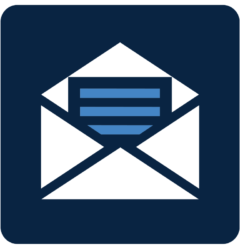
Awesome Newsletters for Web Developers and Designe
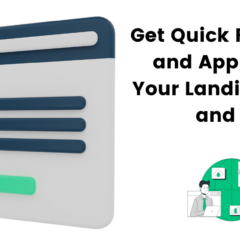
Launch Landing Pages Faster: Get Quick Feedback an
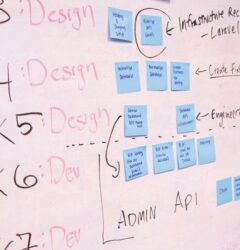
Why is prototyping important?
Request demo.
Request a Personalized Demo To Know More About zipBoard
Recent Posts
- Streamline AEC Document Management and Collaboration with zipBoard March 17, 2024
- How Kanban-Based Workflow Visualizations Make Construction Progress Tracking Easier for AEC Project Teams March 16, 2024
- The Role of Automated Testing in Bug Tracking and Software Quality Assurance March 10, 2024
- 7 Proven Strategies to Improve Architectural Project Management at Your Firm February 26, 2024
- 11 Best Architecture Design Software Used in Practices (Free and Paid) February 12, 2024
All Features
Bug Tracking
Visual Review and Feedback Tool
Collaboration
eLearning Review Tool
Simplified Issue Tracking
Online Proofing Tool
PDF Annotation Tool
For Agencies
For Software Development
For Enterprises
For eLearning Development
For Construction Submittal Management
Architectural Firms/Agencies
For AEC Teams
Best Document Approval Software
Video Review and Collaboration
Translation Review and Collaboration
Free Resources
🆕Webinars/Events
Video Library
Case Studies
Integrations
Microsoft Teams
Lambda Test
zipBoard vs “ ”
zipBoard vs Bugherd
zipBoard vs Marker
zipBoard vs UsePastel
zipBoard vs Usersnap
zipBoard vs Drawboard
zipBoard vs Ziflow
zipBoard vs Bluebeam
zipBoard vs Autodesk Docs
zipBoard vs Frame.io
Help Documents
Comprehensive Guides
Help Videos
Privacy Policy
Terms and Conditions
🔗zipBoard's Affiliate Program
©️ Copyright 2023 zipBoard Tech. All rights reserved.
Sep 05, 2022 · 8 min read
Problem-solving skills of great developers
Developers are not strictly bound to doing plain technical work – quite interestingly opposite; development entails deep thinking and putting great focus on problem-solving tasks.

Marija Neshkoska
Content Writer
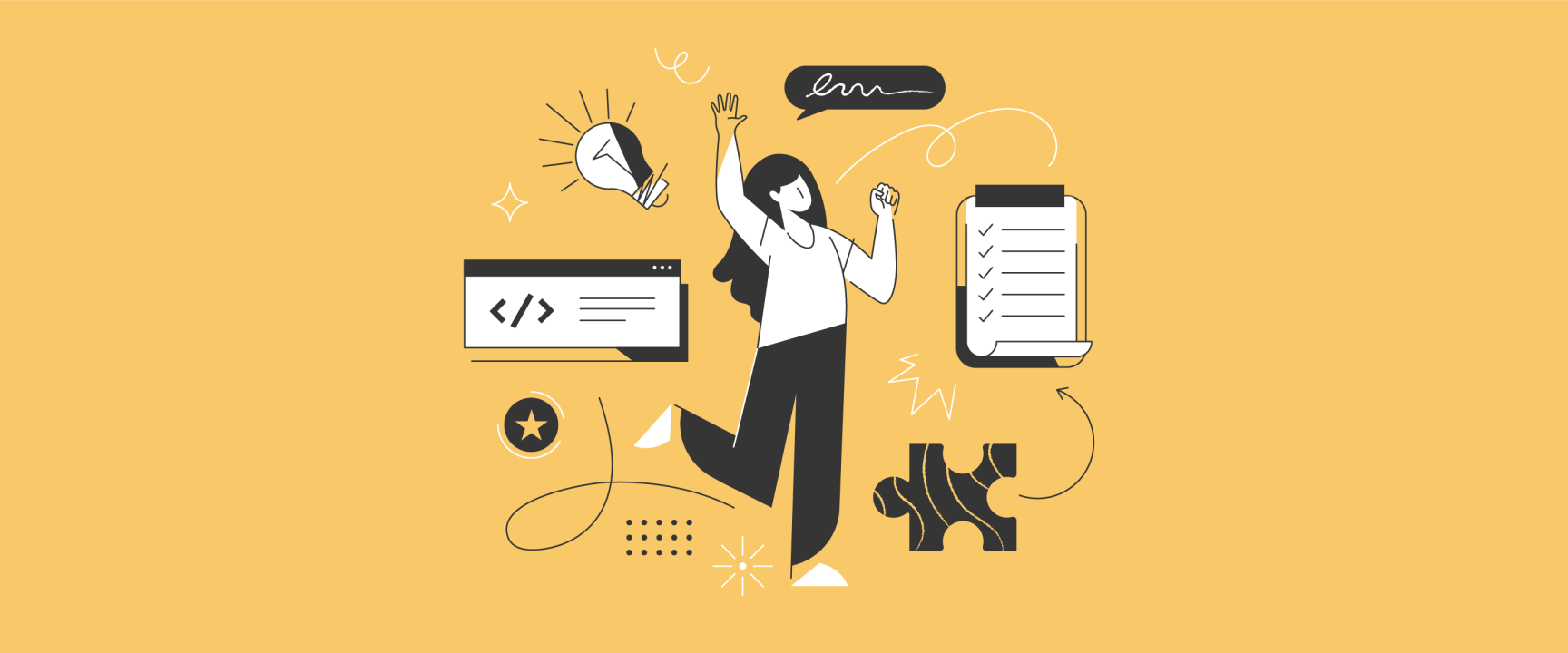
Find your next developer
Engaging in strategic and parallel thinking
Reusing solutions, mastering abstraction, using a variety of tools and platforms, adopting a data-flow mindset, dividing and simplifying workload, adding challenges in leisure time activities too, the takeaway.
This profession requires a lot of practice, and all experienced developers back this up. The basis, the sole start, and continuation of programming and development mean that these professionals hone their problem-solving skills daily. How developers think, speak, engage in communication (including mind-exercising activities) all sum up how they solve problems and think ahead during a task.
Practicing problem-solving doesn’t happen intentionally most of the time, and it could be said it is a type of mindset, a type of curiosity to get to the bottom of things most efficiently. Finding a solution is one thing, but enjoying the process of analyzing and overviewing is what completes the whole mental process of problem-solving in development.
With this said, we could conclude that seeking an easy way out for solutions is not enough for devs, and they need to engage mentally and sometimes even for hours on end once that deep focus starts. Working in development (and programming) includes a great passion for it foremost, and a lot of patience, as well as the ability to engage in long sessions of thinking and delving into uninterrupted focus waves. Later, this results in excelling in a specific development field as well.
In the article below, we will mention a few of the best problem-solving skills that all great software developers have in common and some comments on how all that can be achieved.
Strategic thinking is one of the best things someone could acquire, master, learn, and practice. This type of thinking, where you know how to recognize and anticipate something in advance, teaches you to calculate risks beforehand and avoid any faulty maneuvers down the road. It is a logical, rational, and calculated way of thinking through leveraging an analytical mindset.
Parallel thinking was a term well known to ancient philosophers and their approaches. It refers to thinking in more than just one direction, similar to a debate, but without any seemingly negative strategies resembling attacks and defensiveness. Instead, parallel thinking options are explored, possible solutions are thought through, facts are considered, until you finally reach a conclusion.
Strategic and parallel thinking is undoubtedly a significant asset when you need to study or practice something specific, and we can assume how valuable they are in the development industry.
In this case, a great developer can focus on one thing, for example, but still do more than one task at a given moment . When devs click and type, they already anticipate what would be needed next or what they need to focus on to resolve bugs or errors efficiently . In this way, developers think of all the possible interactions on the screen and use their ‘perspectives’ to think ahead and apply the best possible actions/solutions.
If something worked in the past, why can’t it work again? Devs have no issue using a previous efficient solution; as long as it works and does not interrupt the whole process, it can and should be reused to get a desirable result.
Problem-solving doesn’t always need to be perceived as complex , and the famous ‘Occam’s Razor’ of obvious, simple, and quick solutions can be (re)applied in many development processes.
Great devs use tools and practices that are already used and available and thus simplify their work. Where applicable (and where the task doesn’t require building something from scratch), they achieve excellent results with fewer resources.
Anyone can improve their problem-solving skills by practicing ‘abstraction.’ So, suppose parallel and strategic thinking refers to imagining possible situations, variants to existing conditions, and even possible consequences of a given action. In that case, abstracting is on the other side of the spectrum – a deep focus on the crucial thing only. Let’s elaborate.
Abstracting is crucial for developers, of course, and it’s part of building the mindset needed for this industry. But more precisely, in development, and more specifically in OOP (Object Oriented Programming), it means that the dev works exclusively with the most relevant data and ‘hides’ the rest of the data that’s not crucial at that moment in time.
Abstraction is one segment out of the three aspects of OOP, with the remaining two being ‘encapsulation’ (closely controlled access and hiding specific data) and ‘inheritance’ (transfer of data from ‘parent’ to ‘child’).
But why and how is abstraction an essential problem-solving skill? It’s simple. The dev focuses intensely on the core of the specific task without being distracted by the information they do not need at that moment . This saves time and reduces complexity overall. Perhaps this goes hand in hand with ‘work smart, not (always) hard.’
Of course, in most cases, familiarity or reusing something is practical, simple, or even needed. But, without the curiosity to propel further career advancement, sometimes developers are not motivated enough to apply this notion to practice. This is especially true in computer science and development, where writing clean code or even understanding the underlying structure of application development can make or break a product before launch.
Great devs are curious; they want to delve into deep focus, just as much as they want to explore tools and estimate how useful they’d be for their tasks . This could apply to a different programming language than the one they’ve already mastered, trying out a new technique in the development process, or even experimenting with various frameworks.
Ideally, great devs should know all the ins and outs of the industry – if one framework doesn’t work, they try another; if one programming language is not ideal for the current project, it might be the best solution for another.
Or, to find a solution to a problem with data flow in mind. This means that the excellent ‘problem-solver’ imagines the data flow and the systems in various scenarios. More precisely, envisioning how data works is not the simplest task—there are embeddings, manipulations, changes, and data transformations present in multiple steps of the app development process.
A great dev focuses on the outcome by visualizing the main goal and subgoals. Often, the mindset here includes diagram envisioning and thinking in terms of structures and sets embedded with one another or in some type of hierarchy . In summary, it involves thinking about how data moves through the system.
Devs know that “the devil is in the details”, or that focusing on smaller tasks will lead to resolving the big issue while at the same time focusing on the big picture as well.
For example, correcting bugs in the code is one way to explain this. Devs look for the bug by reviewing and looking over the entire code from start to finish—the problem may be something as tiny as a comma or a dot in the wrong place.
For a great dev to resolve a specific problem, they first need to understand the problem, and they do this by going through the entire code or each previously completed small task, for example. Division in tasks reduces the workload complexity and makes the dev focus more on possible minor issues they encounter along the way .
Last but not least, almost all great devs also engage (and excel) at mind-exercising leisure activities. Activities like chess, playing cards, and strategy board games all come in handy when thinking about the next move and what the other players/opponents might do next. It is no wonder that some great devs are outstanding gamers as well.
Everyone could benefit from adding a bit of challenge to everyday leisure activities, not just great software developers. These game-playing activities take communication skills to a whole new level by being all about focus, discipline, calculations, and logical thinking. What we learn from such activities can be a solution even to an everyday problem, not just the issues arising in the development job.
Interestingly enough, great devs already know how to think tactfully, logically, and with anticipation for what comes next, so they apply this thinking even in the choice of their leisure activities mentioned above.
The CTO's guide to different hiring models
How to hire for a fast-growing tech company
Good problem-solving skills combine various skills, experiences, mindset schemes, personality traits, and interests.
Problem-solving skills are an irreplaceable asset to have, both professionally and personally. And truth be told, all great devs have outstanding problem-solving skills. But one thing is certain, for mastering problem-solving, practice makes perfect.
Was this article helpful?
Related articles
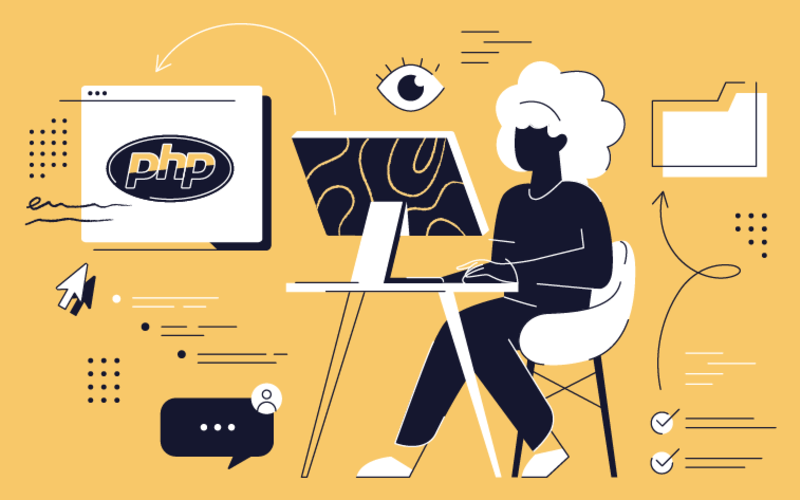
Jul 25, 2023 · 18 min read
Trends and changes a skilled PHP developer should know in 2024
- Web development
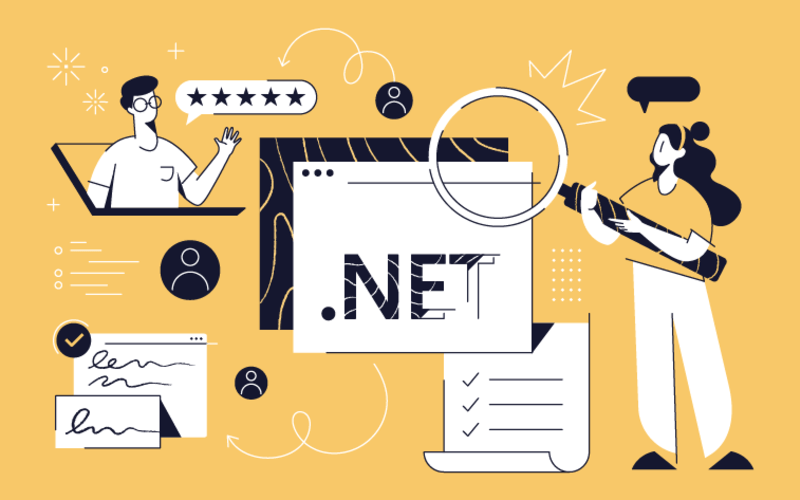
Jun 14, 2023 · 14 min read
10 interview questions I would ask as a Senior .NET developer
- App development
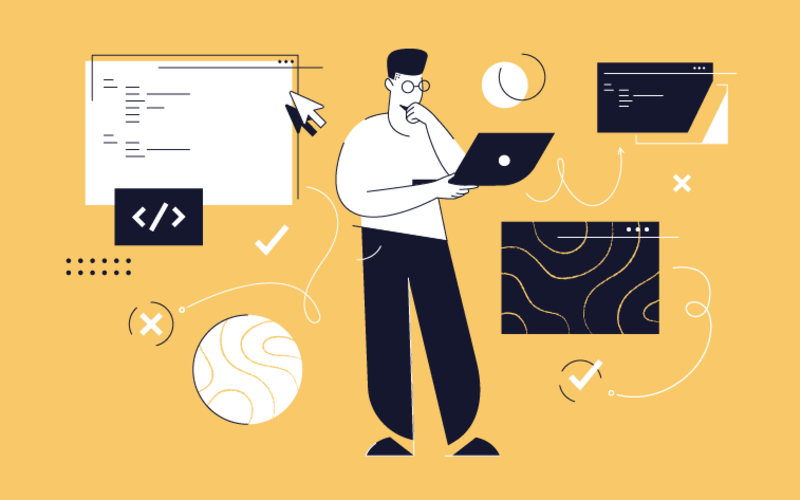
Jun 12, 2023 · 25 min read
Five suggestions for PHP code test assignments
Find your next developer within days, not months.
We can help you deliver your product faster with an experienced remote developer. All from €31.90/hour. Only pay if you’re happy with your first week.
In a short 25-minute call, we would like to:
- Understand your development needs
- Explain our process to match you with qualified, vetted developers from our network
- Share next steps to finding the right match, often within less than a week
Not sure where to start?
Let’s have a chat
First developer starts within days. No aggressive sales pitch.
What Is App Development?

App development is principally completed by teams of software engineers , with input from project managers, data scientists , designers , writers and additional personnel on the content that goes into the app.
What Do App Developers Do?
App developers are responsible for the development of all the code, assets and frameworks that form an application.
App developers are software engineers who construct applications for use on the web, on operating systems like Windows and MacOS or on mobile platforms like iOS and Android. These engineers are responsible not only for writing the code and constructing the app, either individually or as part of a team, but also for brainstorming ideas, testing functionality and researching algorithms that will allow the app to function and meet its goal.
Along with working alongside other app developers as part of a team, app developers often work with graphic artists, UX designers , data scientists, senior data scientists , project managers , marketing teams , copywriters, SEOs and many other parties that all play a critical role in the creation of successful apps.
Related Reading From Built In Experts 10 iOS Development Tips for Swift and Xcode
What Programming Language Is Used for Mobile App Development?
Swift and Objective-C are used when developing iOS apps while Android apps can be developed using Java . React Native facilitates development for both.
Although Objective-C is the original programming language used for developing iOS applications, Swift is considered the best programming language for building iOS apps today. Swift offers better memory management, relaxed syntax rules and a shorter learning curve than Objective-C. All of Apple’s iOS frameworks are written in Objective-C, however, so many developers will at least maintain a portion of their app’s code in this language.
Android applications are most often constructed using Java, which is Android's official programming language. The language’s long history and reliability make it a natural choice for many developing apps for these devices. Other programming languages like the open-source Kotlin and the high-powered C/ C++ are also widely used on the operating system, however.
Beyond developing applications for specific operating systems, the hybrid React Native framework allows developers to build applications that can be launched in either environment. Released by Meta in 2015, React Native incorporates several UI frameworks to facilitate functional cross-platform development using JavaScript programming, leading to widespread adoption in the app development industry.
How Much Does it Cost to Build an App?
The high median cost to build an app is $171,450 but can range from $30k through $700k. Apps often take between three and twelve months to build.
According to a 2018 survey from Clutch , the median cost for developing an app on any platform is $171,450, with a range from $30k-$700k. There are many factors that go into this cost, including resources available to the developer, the business model the developer is targeting, the type of app being developed, the quality of competitors’ apps, how complex the app is, how much functionality is built into the app, design expenses, market share and the time it takes to develop.
Additionally, the country the app is being developed in will be a factor in its development, due to labor laws and production variables. These factors must be considered and weighed heavily when determining a budget, scope and timeline for an app’s creation.
Most apps can be built between three and 12 months, but more extreme builds can take years to complete. Ongoing development and continuous improvement mean an application will continue to be developed indefinitely.
Built In’s expert contributor network publishes thoughtful, solutions-oriented stories written by innovative tech professionals. It is the tech industry’s definitive destination for sharing compelling, first-person accounts of problem-solving on the road to innovation.
Great Companies Need Great People. That's Where We Come In.
Filter by Keywords
The 10 Best Problem-Solving Software to Use in 2024
Engineering Team
February 14, 2024
Do you want a solution to help your teams work well together, reduce friction, and speed up productivity?
The best problem-solving software has all the answers for you. Problem-solving software helps find bottlenecks, simplify workflows, and automate tasks to improve efficiency. The result? Communication is easy, and your team enjoys a collaborative work environment.
Problem-solving software gives you the right visualization tools and techniques to better articulate your ideas and concepts.
That’s not all; it also automates repetitive tasks while your team focuses on brainstorming and ideating.
In this article, we’ll cover the best problem-solving software and highlight its various features, limitations, customer ratings, and pricing details to help you make an informed decision.
What Should You Look For In Problem-Solving Software?
1. clickup , 2. omnex systems , 5. meistertask, 6. teamwork, 10. airtable .
Businesses encounter many challenges, from operational inefficiencies and customer complaints to financial discrepancies.
As your team slowly navigates through these issues, having problem-solving software with the right features will reduce the hassle. Before investing in one, consider some of these following factors:
- User-friendly interface: The software should have an intuitive and easy-to-use interface to minimize the learning curve for users
- Versatility: Look for software that addresses various problem types and complexities. It should be adaptable to different industries and scenarios
- Mind maps and Visualization features: Get yourself problem-solving software solutions that offers mind maps and other visual tricks. It must be a digital canvas for your team to brainstorm ideas, connect the dots, and execute strategies
- AI assistant: If your team is stuck with repetitive mundane tasks, then it’s time you let AI take over. With the right problem-solving tool comes in-built AI that handles everyday tasks, leaving your team to focus on the important stuff
- Automation capabilities: Look for problem-solving process that’s all about automation. This way, you ensure efficiency and effectiveness without the grunt work
- Goal tracking: Your efforts improve when you optimize your tracking process. You need goal monitoring and tracking features to ensure you are on track
- Cost-effectiveness: Look for the features that various plans offer and compare them to choose an option that provides maximum features while the benefits justify the cost
The 10 Best Problem Solving Software In 2024
While you have many options, select the one with the right features that suit your needs .
Check out our list of the ten best problem-solving tools to ensure you have the features to solve complex issues effectively:
Henry Ford once said that success takes care of itself if everyone moves forward together. ClickUp problem-solving software helps you succeed by ensuring all your team members are always on the same page.
With its live collaboration, you can see if your teammates are looking at or editing documents. Also, edit documents together in real-time. Moreover, any changes on any device are updated instantly, so nobody falls behind.
The whiteboard feature is super helpful in getting your team together for brainstorming and ideating. As problem-solving involves generating and evaluating multiple ideas, the whiteboard helps write, modify, and build ideas together.
Now that you have brainstormed on core problems, you must establish a clear visual reference point for ongoing analysis. That’s where the ClickUp mind maps feature stands out. Create a hierarchical structure, with the main problem at the center and subtopics branching out.
Since these maps have interconnections, it is easy to visualize connections between different elements. This feature effectively identifies possible cause-and-effect relationships in a problem.
ClickUp best features
- Documentation: Address and solve problems by storing and accessing project-related documents in ClickUp Docs
- Mind maps : Identify critical connections, uncover insights, and implement creative approaches by visually mapping relationships between concepts and information with ClickUp Mind Maps
- Task prioritization: Make problem-solving easier for your software developers—sort tasks by urgency. This helps your team focus on the most crucial aspects, making problem resolution more efficient
- Virtual whiteboards: Enhance collaborative problem-solving and critical thinking through ClickUp Whiteboards . Brainstorm, visualize ideas, and collectively work towards solutions in an interactive setting
- Goal monitoring: Set and monitor business metrics to address challenges, track progress, and ensure the software development team remains aligned with objectives
- Custom access rights: Customizing access rights ensures that the right individuals have the necessary permissions to contribute to problem resolution
- ClickUp AI: Use ClickUp AI to automate repetitive tasks, analyze data for insights, and enhance productivity in tackling complex problems
ClickUp limitations
- Learning curve is involved in fully grasping all features and capabilities
ClickUp pricing
- Free Forever Plan
- Unlimited Plan: $7 per month per user
- Business Plan : $12 per month per user
- Business Plus Plan : $19 per month per user
- Enterprise Plan : custom pricing
- ClickUp AI: $5 per Workspace on all paid plans
ClickUp ratings and reviews
- G2: 4.7/5 (2,000+ reviews)
- Capterra: 4.7/5 (2,000+ reviews)

Omnex’s problem-solving software has many helpful features to track, manage, and solve problems quickly. It’s a one-stop shop for dealing with internal and external issues.
The platform is also customer-centric, which responds to customers in their preferred formats. This ensures a tailored and user-friendly experience, further enhancing problem resolution through seamless interaction with stakeholders.
Omnex best features
- Define timelines and metrics for problem resolution
- Leverage several problem-solving tools, such as 5Why, Is/Is Not, etc
- Respond to customers in various formats, including 8D, 7D, and PRR
Omnex limitations
- Initiating projects involves many steps
- Temporary delays may occur
Omnex pricing
- Omnex has custom pricing plans

Hive is another excellent platform to instruct your teams better while solving complex challenges and enhancing their problem-solving skills. It’s highly interactive and lets all your team members view what’s happening and express their opinions simultaneously.
Collaborative work management helps you solve issues effectively. Hive is your virtual file cabinet where sharing documents with different teams and collaboratively working becomes more accessible.
Hive best features
- User-friendly interface ensures seamless navigation
- Gantt view helps in mapping out project timelines
- Project hierarchies allow for easy task execution
- Kanban view allows you to understand progress better
Hive limitations
- Being a relatively new tool, it needs frequent updates and additional features
- There are occasional bugs that slow down processes
- Locating notes from tasks and meetings is time-consuming
- Auto-generated reports are not always accurate
- Apart from ticketing, the platform needs some intuitive features
Hive pricing
- Teams: $12 per month per user
- Enterprise: custom plans
Hive customer ratings
- G2: 4.6/5 (480+ reviews)
- Capterra: 4.5/5 (190+ reviews)

Asana is a popular problem-solving tool that speeds up decision-making . It improves project management , and its many integrations are useful. The well-organized project documents make it easy to find what you need quickly.
It’s excellent for managing many small projects and suitable for teams without complex workflows or collaboration features.
Asana best features
- The rules and workflow feature helps automate repeating activities
- Customizable workflows help teams adapt the tool to their unique needs
- For easy understanding, organize tasks as a list, calendar, timeline, Gantt chart, or Kanban board
- Integrate with popular tools and apps such as Google Drive, Dropbox, Slack, Zoom, Microsoft, etc.
Asana limitations
- Inefficient for handling larger projects with sub-projects and multiple workstreams
- Limited capability to measure project deviations from original plans
- Lack of comprehensive workflows and customizable animations, a feature some competitors offer
- Pricing is less favorable for smaller teams; advanced features like custom fields, portfolios, and timeline views are only available in premium plans
Asana pricing
- Personal (free)
- Starter: $10.99 per month per user
- Advanced: $24.99 per month per user
Asana customer ratings
- G2: 4.3/5 (9,520+ reviews)
- Capterra: 4.5/5 (12,290+ reviews)
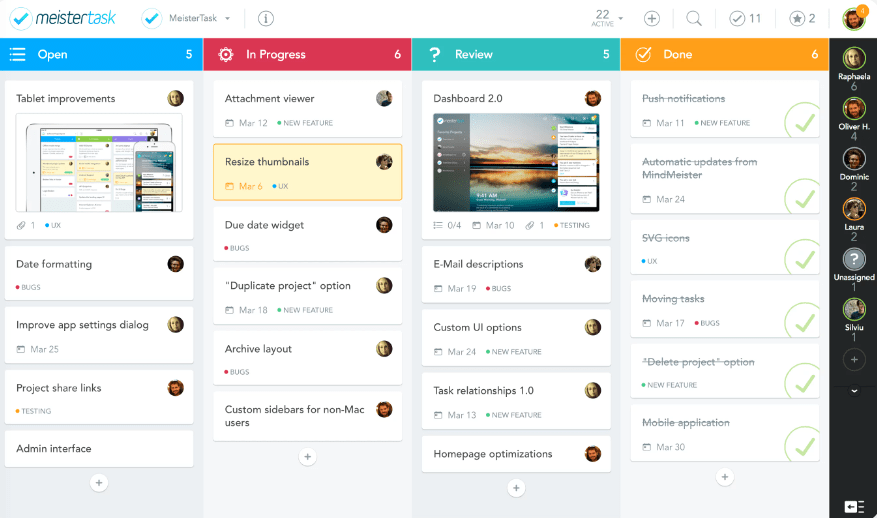
Mesitertask is one of those problem-solving tools that offers strong kanban boards. These boards visualize the workflow and make it easier to identify bottlenecks and trace issues back to their source. Such visualizing features are similar to the ones found in the best root cause analysis tools .
A customizable drag-and-drop feature further allows users to rearrange and prioritize tasks easily. Therefore, your team members will easily play around the field and segregate tasks effectively.
Meistertask best features
- Gain a visual representation of task timelines with a timeline view
- Streamline processes with automated workflows
- Easily categorize and prioritize tasks within sections
- Monitor and analyze time spent on tasks for valuable insights
Meistertask limitations
- Unnecessary negative space impacts task visibility
- Limited report and analytics features, not accessible offline
- Confusing registration process
Meistertask pricing
- Basic (free)
- Pro: $6.50 per month per user
- Business: $12 per month per user
- Enterprise: custom pricing
Meister task ratings and reviews
- G2: 4.6/5 (170+ reviews)
- Capterra: 4.7/5 (1130+ reviews)
Teamwork is another viable problem-solving software dealing with operational challenges. It provides a clear overview of task assignments, project profitability, and other essential details.
When combined with effective brainstorming techniques , such a clear division of work will help you solve complex issues faster.
Teamwork features
- Get four distinct project views, including List, Table, Boards, and Gantt
- Efficient task management simplifies the process of creating and assigning tasks to users, enhancing team collaboration
- The time tracking feature helps determine billable hours, aiding in project budgeting and resource allocation
- Standard communication features, such as commenting and mentioning coworkers, are seamlessly integrated, promoting practical collaboration
Teamwork limitations
- You need to subscribe to premium plans to unlock advanced features
- The user interface is intricate and poses a challenge for some users
- Certain features, like the reminder function, do not operate on mobile apps
- Continuous email notifications have the potential to disrupt focus, as not all updates or status changes are crucial
Teamwork Pricing
- Free Forever
- Starter: $5.99 per month per user
- Deliver: $9.99 per month per user
- Grow: $19.99 per month per user
- Scale: custom pricing
Teamwork Customer Ratings
- G2: 4.4/5 (1,070+ reviews)
- Capterra: 4.5/5 (830+ reviews)

Trello is another good option if you are searching for efficient problem-solving software. With powerful task management tools, it ensures you handle your issues efficiently.
However, Trello’s communication and collaboration tools are not up to the mark compared to other problem-solving tools. Also, it relies heavily on integrations to do the heavy lifting.
Trello Features
- Streamline your workflow effortlessly by arranging tasks with a simple drag-and-drop interface
- The project map feature gives a complete overview to help you visualize tasks, dependencies, and progress at a glance
- Focus on what matters the most and prioritize tasks effectively with its intuitive tools
- Stay on top of your responsibilities with dynamic to-do lists
Trello Limitations
- The free version imposes limitations on file attachments, a lack of advanced integrations, and automation
- Manually arranging Trello cards one by one is a time-consuming task
- There is a lack of functionality for creating a comprehensive dashboard or Gantt chart to provide a clear overview
- The absence of restrictions on card movement poses a security risk, with anyone accessing and potentially disrupting the board
- Trello becomes less practical when the board becomes densely populated with cards
Trello pricing
- Standard: $5 per month per user
- Premium: $10 per month per user
- Enterprise: $17.50 per month per user
Trello customer ratings
- G2: 4.4/5 (13,000+ reviews)
- Capterra: 4.5/5 (23,000+ reviews)

Wrike is one of the preferred project management collaboration tools that help businesses of all sizes. With preconfigured templates for tasks, workflows, and communication, it takes the burden off your shoulders.
It also has a user-friendly dashboard with enterprise-grade tools to manage recurring and one-time projects.
Wrike best features
- Planning tools to outline tasks, set deadlines, and allocate resources
- A clear visual overview helps in identifying potential challenges
- Detailed reports to analyze project performance
- Helps efficiently address issues by prioritizing tasks
Wrike limitations
- There are no options to view projects on the Kanban board (only tasks)
- Basic project management features are missing, such as time breaks for a task
- Pricing remains on the higher end
Wrike pricing
- Professional variant: $9.80 per month per user
- Business variant: $24.80 per month per user
Wrike customer ratings
- G2: 4.2/5 (3500+ reviews)
- Capterra: 4.3/5 (2540+ reviews)

Monday is a cloud-based open platform, allowing businesses to collaborate better on projects. Explore many pre-built templates or create one from scratch depending on what you need.
Monday best features
- Streamline workflows by making bulk changes efficiently
- Plan and organize tasks effectively with powerful scheduling tools
- Keep a detailed record of project activities, providing transparency and aiding in tracking progress, which is critical for troubleshooting and resolving issues
- Gain valuable insights through customizable views and comprehensive reporting, facilitating data-driven decision-making
Monday limitations
- There is a minimum team size of three required for paid plans
- The free trial lasts only for 14 days
- Advanced features like time tracking are only available in premium plans
Monday pricing
- Basic: $8 per month per user
- Standard: $10 per month per user
- Pro: $16 per month per user
- Enterprise: custom pricing
Monday customer ratings
- G2: 4.7/5 (9,570+ reviews)
- Capterra: 4.6/5 (4,430+ reviews)
Airtable is a cloud-based collaboration platform that combines the simplicity of a spreadsheet with the complexity of a relational database.
It allows users to create and manage databases, spreadsheets, and other types of structured data in a flexible and user-friendly way. With its user-friendly interface, you will quickly organize and track crucial information for problem-solving.
Airtable best features
- Supports real-time collaboration
- Attach files, images, and other multimedia directly to records
- Highlight and format cells based on specific conditions with conditional formatting
- Use pre-built templates for different use cases
Airtable limitations
- While the interface is user-friendly, users unfamiliar with databases may find it initially complex
- For extremely large datasets or complex relationships, Airtable may face performance challenges
- As a cloud-based platform, it relies on an internet connection, and lack of connectivity may hinder problem-solving efforts
Airtable pricing
- Team: $20 per month per user
- Business: $45 per month per user
Airtable customer ratings
- G2: 4.6/5 (2,180+ reviews)
- Capterra: 4.7/5 (1920+ reviews)
Solve Problems to Drive Successful Business Outcomes
It is best to invest in problem-solving software to ensure that problems do not bog down your team and that you have the tools to solve and focus on strategic work. Our list of the ten best problem-solving software should help you find the right fit for your organization.
Thousands of businesses of all sizes choose ClickUp. With ClickUp, you get different tools to map your project, divide tasks, view the interdependence of tasks, allocate resources, and resolve bugs on time. Whether improving team productivity or identifying and squashing bugs, ClickUp does it all!
Get in touch with our team, or sign up for FREE .
Questions? Comments? Visit our Help Center for support.
Receive the latest WriteClick Newsletter updates.
Thanks for subscribing to our blog!
Please enter a valid email
- Free training & 24-hour support
- Serious about security & privacy
- 99.99% uptime the last 12 months

49+ Mobile App Ideas That Haven't Been Made (2023 Update)
Jan 4, 2022
Coming up with a million-dollar mobile app idea could be challenging.
What if we share 53 inspiring mobile app ideas of the future with you?
It would be cool, right?
Also, we will show you 12 new techniques that will help you to come up with even more.
Let’s get started!
53 Innovative Android & iOS App Ideas
Here are 53 innovative Android and iOS app ideas that you can take and start the development right away in 2020.
Some of these ideas are easy to implement even for beginners. As a starting point, you can use one of the open-source Felgo app examples .
1. Grocery Shopping App
The idea is to create a grocery shopping app that suggests shopping lists from the available budget. Items on the shopping list and store recommendations are suggested based on location, budget, date, and history of the purchases.
Additionally, machine learning technology can be implemented based on purchase history and current input.
2. Mood Monitoring App
An Android and iOS app that lets you rate your day and look for patterns that affect your mood.
You would be able to add and evaluate activities, locations, events, that took place during the day. The idea is that the app will analyze your past activities and will look for patterns. Based on that, it will give you suggestions to improve your mood.
Here is an example of an Android and iOS app from where you can get inspired. The app was developed in Felgo , a cross-platform app development tool.
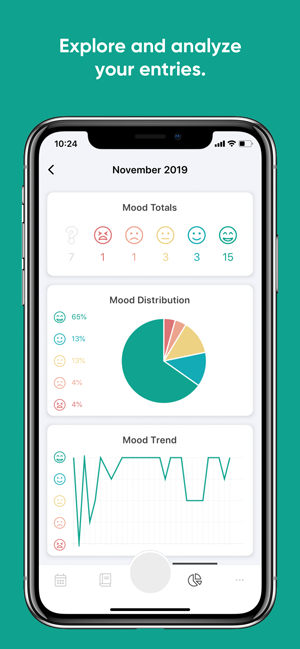
3. Social Networking App for Single Parents
A platform for single parents where they can share their interests, tips, experiences, and thoughts with each other.
This mobile app will match the parents based on the information they provide about themselves (e.g.: number of children, age of the children, location, interest, etc.).
4. Brand Identifier App
This brand identifier app will allow users to learn more about a specific brand or product. By scanning the logo or tag of the item, the mobile app will list articles, information, and news about the manufacturer as well as about the product. In the case of clothing items, it will also tell the users whether it is authentic or not.

5. AR for School App
Many students struggle with understanding certain subjects in school.
This app facilitates the illustration of complex materials taught in classes such as Chemistry or Biology. By applying Augmented Reality technology, the app aims to help students visualize and better understand complex subjects.
You can simply develop augmented reality apps using Felgo , a cross-platform app development framework.
Create your app for Android and iOS with the same source code and tools.
Get Felgo Apps Today!
If you need help with your mobile app development , consult with Felgo’s team .
6. Presentation App
The application enables you to present your 3D models anywhere.
This app will allow you to import your 3D models into your iOS and Android mobiles, and illustrate them wherever you wish.
The idea could be perfectly used for business project presentations as well as in many other fields.
7. Catering Service App
A mobile food ordering app that enables customers to place their orders in advance. Once the order is placed, customers will be informed about the possible time for pick-up.
Through this app, customers don’t have to deal with waiting in line as their order will be ready by the time they arrive at the restaurant.
Feel free to develop and experiment with this idea. You can simply develop the application template for both Android and iOS using the free cross-platform development tool . Once the template is ready, you can tailor the app to different restaurants’ needs.
8. Celebrity Identification App
Have you ever found yourself in a situation where while watching a movie, you just could not remember the name of the actor?
The same identification method could be used for this idea that the popular app, Shazam , was built on.
You can simply take a picture of the celebrity you would like to obtain more information about. Once the picture is run through the app, it will provide you with the most useful information found on the internet.
9. Other Recognition & Identification App
Based on the above-mentioned method, not only songs or celebrities can be identified, but also movies, TV shows, perfumes, etc.

10. Virtual Shopping App
A virtual shopping app that can be used to create a shopping list at a specific store. It would also tell its users whether the selected product is available at the nearest store to their location. In case the items are out of stock, it would also give them a suggested list of where they can collect them.
11. Contractor Finder App
Through this app, users can find contractors in any field. Users can also submit their requirements, compare prices, or read reviews about previous services. They can select their reliable providers based on availability, rating, location, and price.
12. Note Sharing App
Did you miss the lecture, conference, seminar, meeting or a class? Would you like to see the notes from the event, but cannot find anyone who would have it?
The idea behind this app is to create a platform where users can upload, share, or comment on new or existing notes about a particular topic.

13. Parking Spot Locator App
The mobile app that helps you find free and paid parking spots at your location. The app could use GPS, webcams, location, parking data in real-time to find free and paid parking space nearby.
14. Voice-activated Mobile Phone Locator App
At least once in a lifetime, it happened to everyone that they forgot where they left their phone or which pocket they dropped their phone in.
This app could save time trying to go through all the places you might have left your belongings. This mobile app uses voice activation that turns on when you say the code word.
15. Social Attachment App
The mobile app makes socializing easier by helping you find people with similar interests nearby. You can choose topics of your interest, for example cinema, sports, movies, video games, books, etc., then swipe and find people in your area. The process of finding people could be similar to the Tinder app .
16. Table Booking App
A restaurant reservation app that will let the users book a table at their favorite restaurant. Information, such as floor map, availability or the number of seats at the table, are provided upon booking.
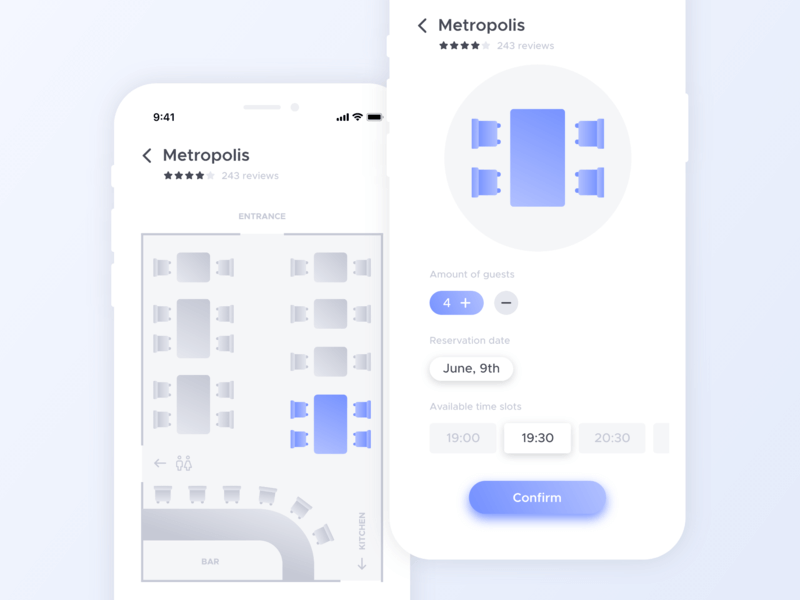
17. Lost & Found App
Did you lose your keys in the carpark? Did you lose your jewelry in the fitting room? Do you know someone who has lost a small item before?
This app aims to connect the lost items with their original owner. Users can upload the items they found at a specific location so that these lost items can find their way back to their owners.
18. Gift Delivery App
The idea is to create a mobile app that people can use to surprise their loved ones with gifts sent directly to their doorstep. Buyers can choose from many goods and services provided by local stores. The store owners can design their store profile as well. Buyers can choose from a great variety of merchandise and can also choose and design the packaging. Once the transaction is made, delivery personnel will pick the item up and deliver it right to the loved one’s hand.

19. Local Party and Event Finder App
A party and event finder app that collects all the available events from different platforms into one place from sources such as Facebook, Meetup.com, Couchsurfing, etc.
It'd give detailed information about the requirements, entry information, time, and venue.
20. Social Wine & Dine App
A networking mobile application that connects you with people nearby to grab something to eat or drink. The app would allow users to connect based on interest, location, and availability. Then, users can start a conversation via direct invitation messages.
21. Expiration Date Tracking App
When was the last time you have nervously taken a sip from the milk container that has been open for days?
This idea provides a solution to this problem. It is a tracking app that keeps track of the expiration dates of the food in your kitchen. Thanks to this app, users will no longer question whether the items are safe to eat or drink in their fridge or not.
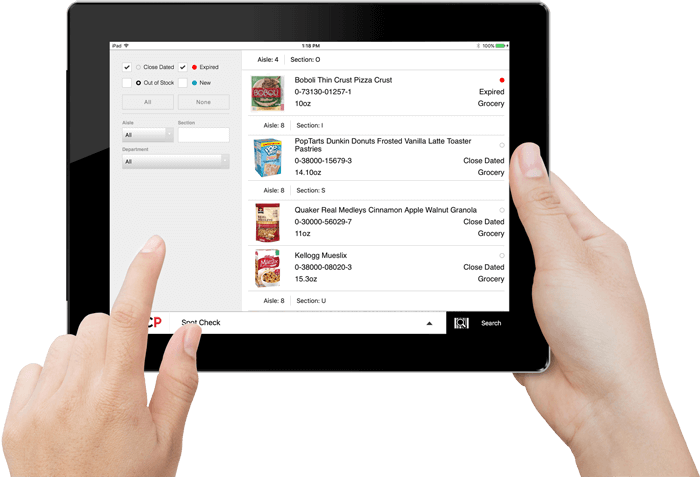
22. Travel App
A travel assistance app that will give its users suggestions of local attractions to visit, cuisines to taste, activities to do based on their interest at a particular location. Data would be retrieved from Tripadvisor and other travel sources, where locals and other travelers share their experiences.
23. Reverse Travel App
A mobile travel app where users can list their interests and based on that it will show them places they shouldn’t visit or cuisines they shouldn’t try due to health reasons such as allergies, special diet, intolerance, etc.
Feel free to develop this travel app idea by combining other relevant features that could be helpful for the traveler.
24. Digital Receipt App
A digital receipt app that will collect all the transactions that you make into the app. It will reduce the overuse of the paper and will make it easier to track the costs and keep receipts.
25. Mall Navigation App
A mall navigation app that displays a detailed map of the mall. This awesome app idea can surely increase customer satisfaction. It will not only make it easier to find the desirable stores, toilets or food courts but would also help the users to find the fastest route to their chosen destination.
Sounds interesting? Check out Felgo’s demo map app and make a fortune by bringing this idea to life.
26. Supermarket Checkout App
Supermarket checkout app that automatically scans the products on your mobile app while shopping. Upon checkout, the mobile app also makes the transaction via integrated e-payment.
Get inspired with this innovative app idea from Amazon Go. You can simply develop this app idea and tailor the concept to the other markets.
Here is a demo version of the Amazon Go, the world’s first self-service checkout mobile application.
27. Architecture & Design App
A virtual interior design app that allows its users to take a photo of a place and design it virtually using augmented reality.
This app could be used for businesses such as interior design agencies, furniture stores, or even school projects. This app will not only increase customer satisfaction but would also save a lot of time and effort to the business owners.
You can develop a similar interior designer app (for Android and iOS at the same time) using Felgo or its mobile app development service .
28. Payment Reminder App
A tracking app that helps its users monitor their bills, subscriptions, and payments via sending automatic reminders about the next payment due date.

29. Delivery App
Do you have a package that you would like to mail but do not know which delivery service provides the best deal? This app idea provides a solution to this problem. It will suggest its users the best delivery companies with the best deals to send their package. The app would create the list based on reviews, location, weight, type, and size.
30. Language Exchange App
A social language exchange app where you can select the languages you would like to learn or practice, and will be matched with people sharing the same interests. Users can choose from study partners as well as teachers.

31. Social Dining App
A social dining app that enables you to find people who would also like to get out of the house, socialize, or wine & dine in your area. To connect with others, users can send invitations to other users and once the invitation is accepted, they can roll and hang out with each other.
32. Taxi Management App
A taxi business management application that helps drivers to monitor their cash flow. Via this app, users can easily track their income, expenses, business supplies, and transactions all in one place.
33. A Social Networking App for Businesses
The idea behind the social business networking app is that it allows its users to find team members for their specific projects in any desired field. This app idea creates a marketplace for professionals.
34. Public Transportation App
The idea behind this mobile app is to notify its users about the best route to take using public transportation. It would also alert the user when it is time to leave to avoid missing the bus, train, or even the plane. It would monitor traffic, delays, scheduled time of departure, and would also consider rush hour.
35. All-in-One Social Media App
The idea behind this app is to combine all social media platforms, such as Instagram, Facebook, Twitter, etc., and use this app to stay up-to-date, post, follow, like, message, share, or comment at one place.
36. Wedding Planner App
This is a marketplace for all wedding-related topics. Venues, musicians, flower shops, designers, etc. can advertise themselves in the marketplace. The future newly-weds can browse through the offers, read articles and reviews, and start conversations with other users.
37. Marketplace for School Supplies
This mobile application would create a platform for students where they can sell, buy, borrow, or lend used school supplies. The service can also be extended to other categories such as furniture, electronic devices, real estate, vehicles, etc. This application would not only save time but would also save money for students on both ends.
38. Tax Management App
This tax invoicing business app will make entrepreneurs' lives easier. The app will calculate taxes that should be paid based on the user’s income and local law. It also might have an integrated feature for generating invoices.
39. Local Travel App
Travel and tourism app that will show its users where, when, and what to do, eat, drink, visit, stay based on the feedback and recommendations from locals.
40. Smart Cooking App
“What should I cook for dinner?” - a question that is asked way too often. This app idea provides a solution to this problem. The idea behind this application is that the users enter the ingredients they have in their kitchen. Then, the mobile app will give them a list of recipes they can use to make food from the available resources. This app could help its users to come up with some great cooking ideas that they mightn’t have done before.

41. Smart Investment App
AI-based Investment App that will do the market research for you, create a thorough analysis and present its finding right to your mobile phone. Based on the given information, you can decide whether you want to invest or not. It will also allow you to make transactions through the app.
42. The Wish-list App
This app lets its users create a career, business, life, or merchandise-based wish-list. If the user creates a career, life or business-related list, it will allow its users to select short-term or long-term goals. Once it is finalized, it will research online and suggest the best ways to achieve them. If it is a merchandise-based wish-list (e.g.: furniture, clothing, electronic devices, etc.), it will give you the best option where to find them based on your criteria.
43. Startup Assistance App
An app that aims to help startup companies and entrepreneurs research common questions, issues, topics and hints and tips about their new business ideas. The app also provides a platform for finding clients, investors, and professionals to recruit.
44. Quick Cash App
Are you looking for someone to mow your lawn, walk the dog, feed your cat, or change your light bulb? This app idea provides a solution to these and many other problems. This is an app where users can find people in their neighborhood to do small work around the house, which takes only a couple of hours.
45. Special Deal Tracking App
A smartphone app that notifies you about nearby deals on the mobile. You’ll get a notification when a store, based on your interest, is offering some kind of special deals, e.g. 50% off. The deals could be related to traveling, fitness, food, etc..
46. Budgeting App for Shopping
This is a grocery budget planner idea that helps people to monitor their spendings on, for instance, grocery shopping. This app will give them a better understanding of how much they consume and spend on groceries. The app will allow users to feed data about their purchases on a daily/weekly/monthly basis. Then the system would then give them analytics that would help them in future budget allocation.
47. Delivery Service App
With this app, users can create their own grocery shopping list and find a delivery service or even a person who can do the shopping on their behalf and get it delivered to their doorstep.
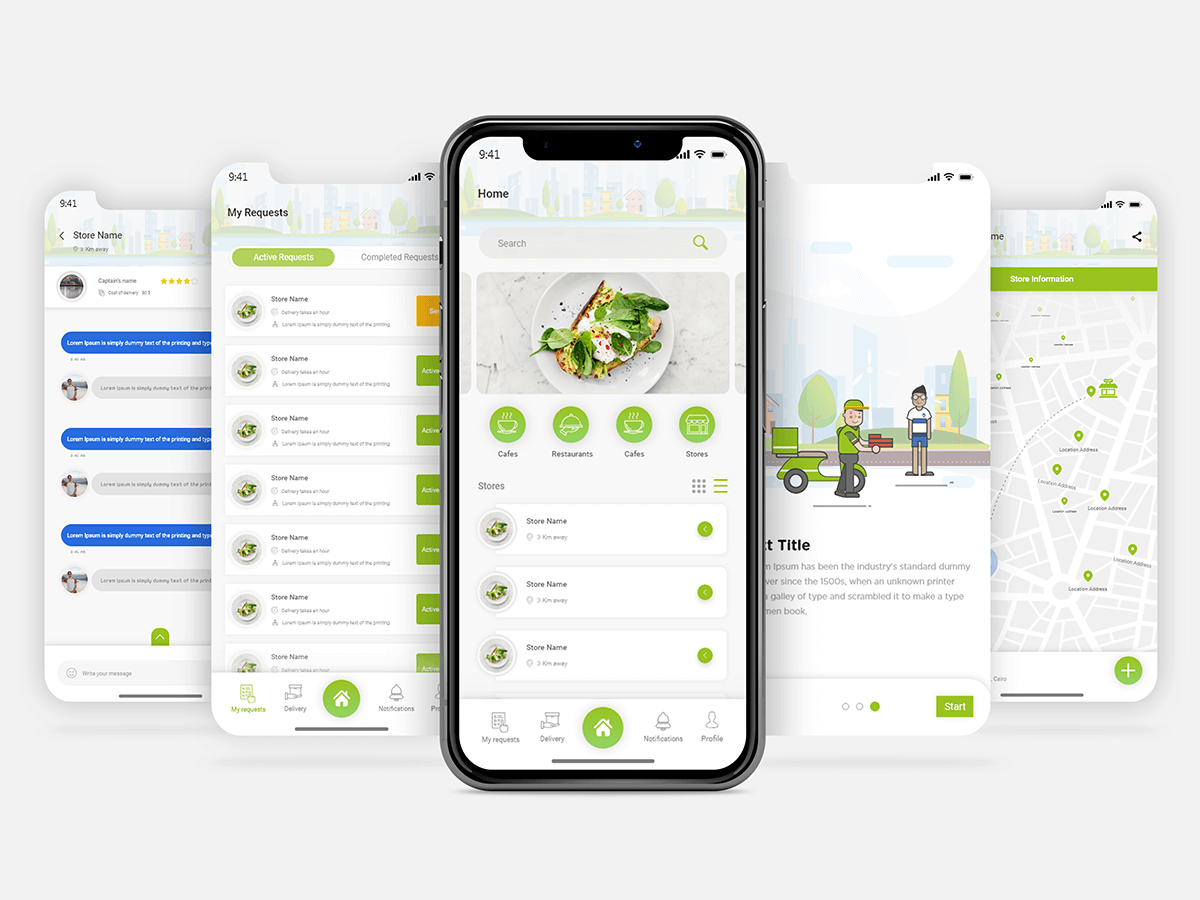
Did this idea catch your attention?
If so, kick-start your own mobile app with Felgo’s basic app then implement additional features, such as messaging and ma p, to your project.
48. Health & Fitness App
Create an app that tracks the body weight and based on that, it gives suggestions on calorie intake, required amount and type of exercise to achieve your desirable body shape. You could include an exercise log in the app as well.
49. Localized Church App
Create a localized mobile church app. where you enable members to take sermon notes, check the prayer list, listen to messages on the go, access small group material, engage with the real-time church news feed, give a donation, and much more. In the app, you can include calendar, sermons, etc. You can get inspired by this example .

50. Coupon Applier App
This app would be developed to ensure that every shopper gets the lowest price possible. The app notifies the shopper about the available coupons. The coupons will automatically be applied upon payment, which will guarantee the lowest prices available. However, the shopper will have the option to select whether he or she would like to use the discount or not.
51. Event Planning & Invitation App
With this app, users can easily plan any event such as weddings, birthday parties, New Year’s Eve parties. It provides its users with all the necessary information, resources, and tips for their next event. Organizing an event with this app will reduce the invested stress and time. Via this app, users can also directly send a customized invitation to their guests.
52. Used Item Giveaway app
The purpose of this localized app is to create a platform for people to donate clothing items, household items, food, school supplies, or any other things that they don’t need and find someone who does. Users can search for items based on type or location. The app would also allow users to auction their items for charitable causes.

53. Social Media Automation App
Android and iOS app that automates social media engagement on Instagram. The idea is that the app can help you grow your Instagram followers and general engagement on your accounts.
With the app, you can automatically follow, like, comment, DM, and engage with the people based on your account’s interests.
12 Ways to Come Up with New Mobile App Ideas
1. start by solving your problems.
Start coming up with app ideas by identifying the frustrations that you have with the current way of doing things.
Look at these problems, research and try to find apps that solve your actual or similar problems. In case you find such apps, try them out and see whether it solves your current frustrations, or not.
Can’t find it? That might be a great start then. It is possible that others may have similar frustrations, which gives you a potential market.

This is a common approach to create new apps and businesses in general. It works well because it encourages you to look at things in simple terms. It’s much easier to fix a basic problem than to come up with a complex and completely new idea. if you understand the problem yourself, then you’re in a good position to fix it.
Canvsly’s Android and iOS apps are great examples of this technique. The app was created by Amit Murumkar. He realized that there wasn’t enough space on his refrigerator for all of his child’s artwork. Some of it had to be removed over time to make space for new paintings and drawings but. But he didn’t have a good way to save the old artwork.
He also felt frustrated because his own artwork was never saved. Then he thought about all the other parents that must have a similar issue. He found a problem he was having, realized that other people had the same problem and created a solution. You can read Canvsly’s full story here .
The key to this technique is to be aware of pain-points in your life or the lives of others. If you or someone you know encounters the same issue regularly with no solution in sight, then you can be the one to fix it.
2. Apply the Freemium Business Model
You might notice that popular paid mobile apps are followed by free alternatives.
Similar applications that target the same audience by offering very similar value for free or at an affordable price.
You can use a freemium business model for your free alternative to the popular paid mobile app. Firstly, focus on satisfying basic needs with your free alternative. After that, you can try to up-sell the product with pro-features.
Have a close look at how some of the successful Android and iOS app companies use the freemium business model.
To give a clear example, you might know about Spotify , which is a digital music, video streaming, and a podcast app that gives its users access to millions of songs. It’s basic functions, such as playing music, are free . But to get its pro functions, you have to upgrade to Spotify Premium.

3. Don’t try to reinvent the wheel - Improve an existing idea
Sometimes mobile applications come into our lives and seem to fix a problem we all have. But what if it doesn’t provide a complete solution or still has room for enhancement?
In this case, it might be time to improve an existing idea by building upon it.

Take a look at what some of the big players in your industry are missing. Try to figure out how you can fill the gaps.
Start by analyzing their products and try to identify what they do and don’t do well. Combine the discovered insights into the application development. Try to make the app stand out with a modern design that follows the latest technology.
Many developers have gained positive results with this technique over the last few years. Whether it’s taking an app and giving it a better UI, or creating a lite version of an essential app, developers always seem to find a way to improve things. And you don’t need to confine yourself to the technological world either. Even traditional businesses are now being improved by app developers.
Uber is a great example of this. Travis Kalanick and Garrett Camp took a simple idea like the taxi and improved the service for end-users with their mobile app. Now they own a company worth over $60 billion. Their success speaks for itself. They didn’t have to invent anything new or convince people to do something they hadn’t done before. They provided people with a more streamlined service that gets them from A to B.
Improving an existing idea is difficult but it has its advantages. A major advantage of this technique is that it’s easy for people to adopt. If you can explain your app by saying “It’s XYZ, but better!”, users will have an immediate picture of what your application can do. And once users see that you’ve improved an idea in a genuine way, it’s hard for them to go back to doing things the old way.
4. Find an industry that lacks recent innovations
When trying to come up with mobile application ideas, try to identify industries that are popular but lack recent innovations.
Augment applied this concept well for their business by creating an augmented reality app for real-estate salesmen.
The application helps them better present and sell their real estate projects and could also be a great substitute for boring brochures.
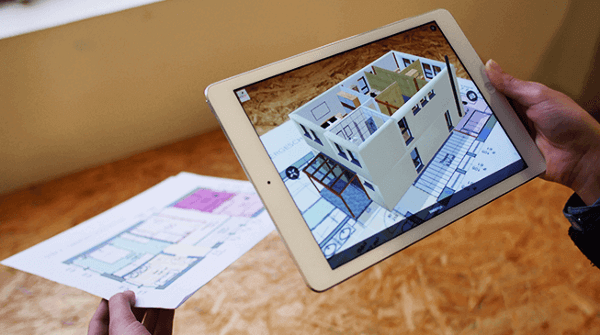
You can apply a similar mobile app idea for different industries and fields.
You can create similar augmented reality apps for Android and iPhone at the same time in Felgo’s cross-platform development tool .
5. Identify innovative mobile application trends
Try to predict the upcoming future. Successful mobile applications are created by innovators who don’t stick with the old technologies or methods. They try to identify trends that will be successful in the future.
You can do this by analyzing recent trending mobile applications. Simply take a look at the top 100 Android and iOS applications.
Moreover, you can have a look at Product Hunt where you can discover the latest mobile apps, websites, technology products, and trending industries.
If you’re good at noticing trends or predicting what’s going to be popular in a few months, then conducting user research is a great way to find inspiration.
6. Conduct user research — talk to your potential users
Try to come up with an app development idea based on your target users’ needs. Start doing it by conducting early user research.
There’s no better way than interviewing your potential users. Try to find out the following:
- How do they currently fix the issue that you are trying to solve with your app?
- What kind of applications do they currently use to solve those problems?
- For what kind of needs do they use that app?
- What do they like and don’t like about it?
- What are they missing, in the app?
By answering these questions, you will have a better understanding of your potential competitors, the actual needs of the targeted users, and the way you should shape the development of the minimum viable product (MVP).
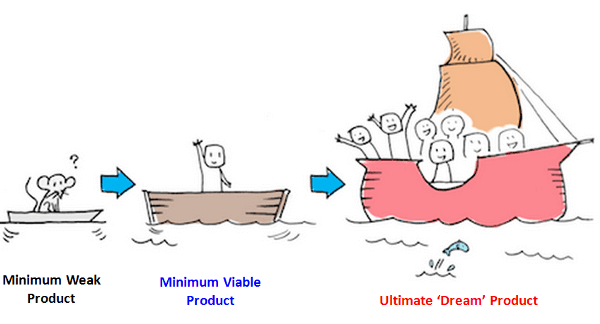
Here is a good example of how Brian Wong came up with Kiip , an in-app mobile advertising platform that uses moments to create meaningful customer interactions and generate highly targeted, custom audiences.
He analyzed potential user behaviors in the most basic way possible.
While traveling by plane, he checked the backseat screens of other passengers to see what they were doing. He noticed that the majority of the passengers were using their devices to play mobile games. All the passengers were highly engaged, but Wong noticed that on-screen ads offered little value to users.
He decided that mobile gamers should be able to earn real-life rewards for their engagement
and so Kiip was born.
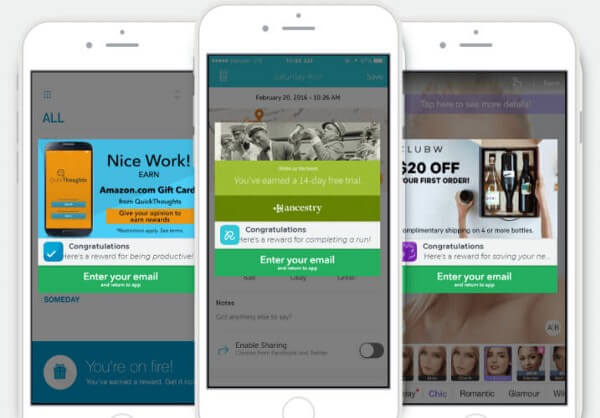
Wong’s user analysis focused on a small cross-section of mobile users but he was able to identify a trend nonetheless. Your user research could be as simple as asking 5 friends what they use their phone for most or a poll on your favorite social media site. The important thing is to gather solid information from reliable sources.
What’s more, try to build up an email list of potential users. You can start experimenting with one of these email campaigns .
Building up an email list will help you to:
- Nurture leads
- Stay in touch with the potential users
- Build up awareness of the upcoming mobile application
- Find beta-testers of the app
All this will help you to get the product market fit before launching the product itself.
7. Make people’s lives easier and faster
Try to understand people’s repetitive processes and create a solution that would ease or speed up their daily routines.
“If I had asked people what they wanted, they would have said faster horses.” — Henry Ford
Coming up with the mobile application idea doesn’t mean that you have to focus on inventing a new product or service.
In fact, focus on identifying what solutions people use to solve certain repetitive processes. Observe and learn more about those processes. Try to identify what solutions do they use for the complete process. Think about what they lack in those solutions and how you can improve them.
8. Copy others’ ideas and localize for your market
Why not localizing globally successful mobile applications? There is nothing wrong with that.
You can get awesome mobile app ideas by looking at popular international applications. Study them and tailor them to your market if needed.
For example, you can create something similar for the local audience like meditation or training apps.
Don’t clone exactly, but take the good aspects from those applications and tailor them to your market.
Instead of reinventing the wheel, try to think about how you can improve the existing wheel.
9. Gain more experience to connect the dots
The more you do and the more experience you gain, the more capability you have to come up with new ideas by connecting dots from your past experiences.
Leonardo da Vinci’s greatest breakthroughs came from connecting the unconnected. In particular, the insights gained by bringing different perspectives together. He defined the innovation as connecting the unconnected.
Bill Gates read books on different subjects . He believes in the power of finding useful things by chance to come up with new ideas.
In a speech from 2005, Steve Jobs captured the spirit of innovation in three sentences:
“ You can’t connect the dots looking forward; you can only connect them looking backwards. So you have to trust that the dots will somehow connect in your future. You have to trust in something your gut, destiny, life, karma, whatever. This approach has never let me down, and it has made all the difference in my life”
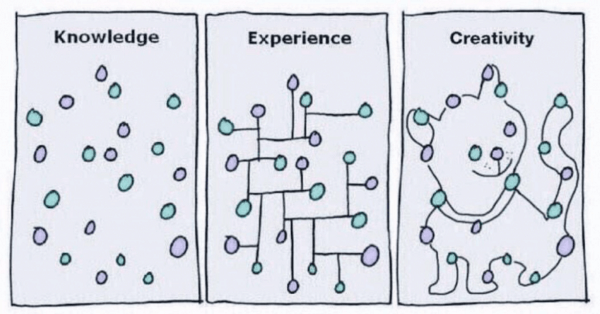
10. Brainstorm like a Pro!
Brainstorming has a bad reputation within certain circles because when it is done incorrectly, it can be a big waste of time. Once you get it right, you’ll even surprise yourself with what you are capable of coming up with. Here are a few quick tips to improve your brainstorming session!
Use a Visual Prompt
When brainstorming, it’s a good idea to keep a certain topic in mind. This helps you to create ideas within a certain context. A visual prompt is an effective way to frame the context you’re trying to work in. Even having a photo of an object can be a useful anchor for your ideas.

Think of the Worst Ideas Possible
This technique may seem out of the ordinary at first, but there’s a clear method to this approach. You start off by trying to think of the worst ideas possible. Write them down and then try to turn these terrible ideas into good ones. It’s a basic approach, and you may not always succeed but if you come up with one good idea then you’ve had a productive brainstorming session.
Challenge Your Assumptions
One of the problems we all face when coming up with ideas is that we work within our own set of assumptions. You can only begin to think outside the box when you challenge these assumptions.
To start off with, think about the kind of app you want to make. Then ask yourself, why you want to make this type of app, why will it be successful, and why you’re the right person to make it. This type of brainstorming helps you scrutinize potential ideas. It helps you discover stumbling blocks before you encounter them in real life. By imagining these stumbling blocks, you consider ways to overcome them or avoid them completely.
11. Keep a Notebook
You’ve got a mobile app idea? Write it down.
Notebook is a great tool for organizing ideas and but it has also been proven that writing down ideas helps you to remember them better as well.
If you’re the type of person that has 100 ideas a day, keeping track of everything in your head can be difficult. How to make an app when you consider that you’ll need to prioritize these ideas at some point, it becomes obvious that keeping a notebook is your best option.

Many of history’s great thinkers and inventors kept notebooks with them. The most famous was Leonardo Da Vinci. His notebooks are artwork themselves. They contain designs for futuristic machinery, mathematical equations as well as his thoughts.
It’s clear that there was a way for Da Vinci to keep track of his ideas. If it worked for one of the greatest geniuses of all time, it might help you come up with an app idea as well.

12. Take breaks
Taking breaks might sound unusual but the stories of people coming up with brilliant ideas in the shower or while taking a walk are true.
This technique has a neuroscience-based explanation as well. When you slow down from awakeness mode, the brain moves to its most creative mode called, on Theta state. In other words, you’re starting to daydream. In the Theta state, the brain often generates ideas when you’re not forcing it to.

Our personal tip for slowing down is to take a 10 minutes break or use the 4–7–8 breathing technique . After your mind slows down, ask yourself questions that help you come up with the solutions.

Start Mobile App Development
Hopefully, you’ve got a better understanding of how to approach the idea generation process itself from the second part of the article.
Now it’s your turn to start the mobile app development.
You can take one of the 53 app ideas and start development using a cross-platform app development tool , where you can make your mobile app for Android and iOS at the same time.
If you enjoyed this post, feel free to share it on Facebook or Twitter.
More Relevant App Development Resources
Qt AR: Why and How to Add Augmented Reality to Your Mobile App
Handle Safe Area Insets, Notch & Display Cutout for iPhone X, iPad X and Android P
The Best App Development Tutorials & Free App Templates
All of these tutorials come with full source code of the mobile apps! You can copy the code to develop make your own apps for free!
How to create a mobile app for iOS & Android with a single code base
How to support multiple languages and internationalization in your mobile app
Common Widgets & Controls in a cross-platform App
How to support multiple screen sizes & screen densities — Responsive App Guide
Guide for App Layout
Guide for App Navigation
How to add native code to your mobile App
How to easily style your App with Themes
How to add Animations to your App
How to add a Chat to your Mobile App
How to make a Weather App accessing a REST weather service
Conference App Template
Widget Gallery App Template
Twitter App Template
Messenger App Template
Property Finder App Template
App Development Video Tutorials
Make Cross-Platform Apps with Qt: Felgo Apps
How to Add In-App Chat or Gamification Features to Your Mobile App
How to Make a Mobile App with Qt Quick Designer (QML Designer) & Felgo
Find the Best Demos and Examples
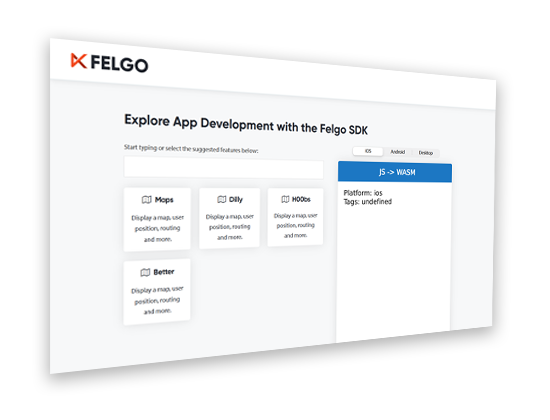
Check out this quick tour to find the best demos and examples for you , and to see how the Felgo SDK can help you develop your next app or game!
Blog Search

Most Popular
Feb 4, 2021
Jul 21, 2020
Jul 7, 2020
Jun 17, 2020
Mar 26, 2020
Latest Posts
Jan 25, 2024
Jan 11, 2024
Dec 13, 2023
Nov 21, 2023
Nov 20, 2023
- App Development
- Game Development
- For Qt Developers
- Product Updates
Sign Up and Download for Free
If you plan to use Felgo in your company, use your company email to start your free Business evaluation!
Remember Me
Sign Up Now
As part of the free Business evaluation, we offer a free welcome call for companies , to talk about your requirements, and how the Felgo SDK & Services can help you. Just sign up and schedule your call .
Sign up now to start your free Business evaluation:
- Free personal evaluation call
- Access to all Felgo Business license features
- Up to 5 hours of free professional services
- Private Slack channel
- Priority support via Email or screen sharing

Now Hiring: We're looking for talented individuals to join our team!
- We are hiring!
Solving Real-World Problems: 12 Apps With Impactful Ideas

By Anshum Chauhan

Why Consider Mobile Apps to Solve a Real-World Problem ?
12 apps with impactful ideas, the bottom line.
In today’s quickly expanding digital ecosystem, the power of technology is no longer limited to entertainment and convenience; it has become a driving force in tackling some of the most important real-world concerns. Smartphones have changed the way we approach and deal with a wide range of societal, environmental, and personal challenges. Mobile app developers all across the world are harnessing the power of mobile apps to make positive change, from improving daily routines to transforming industries. This convergence of technology and social transformation has spawned a new wave of apps that are not only transforming the way we live, but also defining the future.
In this post, we’ll look at twelve superb mobile apps for real-world challenges that have elevated the concept of problem-solving to new heights. Each app represents a distinct approach to solving real-world problems, illustrating the boundless possibilities that exist when technology and inventiveness collide. So join us on a voyage into the transformational landscape of mobile applications, where creativity knows no bounds and real-world challenges are met with simple and creative solutions.

1. Accessibility
Apps offer quick and simple access to a variety of solutions that can be accessible whenever and wherever smartphones and other portable devices are used. Users are able to solve issues wherever they are because of this convenience, which makes their life more effective and productive.
2. User-Friendly Interface
The vast majority of mobile applications (apps) are developed with an intuitive user interface, making them available to users who have varied degrees of experience with technology. The accessibility and user-friendliness of mobile applications (apps) draw in a larger user base, which means that more individuals are able to make use of the solutions that apps provide.
3. Real-Time Solutions
A great number of mobile applications (apps) offer real-time solutions, enabling users to deal with pressing issues and obtain instant feedback or assistance. Because of their speed and responsiveness, apps are extremely useful in circumstances where time is of the essence.
4. Connectivity Collaboration
Multiple mobile applications encourage users to connect with one another and work together. People can work together to find solutions to problems that affect all of them by forming communities and networks, which also fosters a sense of camaraderie and mutual support among the participants.
5. Cost-Effectiveness
A great number of mobile applications provide solutions that are more efficient and less expensive than more conventional methods or services provided in person. Due to the low cost, they are available to a wider variety of consumers, including those who have limited financial resources.
The potential for mobile applications to have a significant impact is limitless, from encouraging sustainability to improving mental health assistance and supporting education. Here are twelve unique app concepts that have the potential to make a significant difference in people’s and the planet’s lives.

1. MedConnect
When it comes to patient care and communication with medical professionals, the MedConnect app has the potential to completely transform the healthcare system. This impactful app idea was created to give ease to patients, doctors, and hospitals to communicate and collaborate in real-time. MedConnect is an innovative healthcare platform that uses telemedicine, AI, and data security to provide seamless, high-quality treatment to its users. The application provides users with the ability to consult with licensed healthcare professionals online, gain access to a large network of doctors and specialists, and obtain immediate medical treatment in the event of an emergency.
In addition to providing a safe place to store electronic health records, the app also includes features to help users keep track of their medications and provides access to a variety of information about maintaining a healthy lifestyle. MedConnect is a revolutionary step forward in improving patient outcomes and healthcare delivery by prioritizing access, inclusion, and data security.
Key Feature of MedConnect
- Telemedicine Consultations
- Doctor Search and Booking
- Real-time Medical Assistance
- Electronic Health Records (EHR)
- Medication Management
- Health and Wellness Resources
- Security and Privacy
2. GreenFoot
GreenFoot is a great example of a mobile app that not only supports sustainable living but also improves users’ quality of life. The app is intended to enable users to make eco-friendly choices in their daily lives by serving as a complete guide for adopting greener behaviors. This mobile innovation is a ground-breaking and transformative platform dedicated to encouraging sustainable living and environmental awareness. Its user-friendly interface and wealth of features encourage users to reduce their carbon footprint and embrace environmentally friendly behaviors by providing practical recommendations, educational materials, and tailored challenges.
This innovative app solution offers a comprehensive approach to sustainable living, ranging from energy-saving tactics and trash reduction strategies to eco-conscious shopping and green transportation options. GreenFoot not only increases awareness of the significance of environmental stewardship, but it also motivates collaborative action toward a greener, more sustainable future for the globe.
Key Features of the GreenFoot App
- Carbon Footprint Tracking
- Eco-Friendly Tips Recommendations
- Sustainability Challenges Goals
- Sustainable Product Directory
- Community Social Sharing
- Sustainable Transportation Options
- Environmental Impact Tracking Reporting
- Educational Resources
3. EduQuest
With the goal of bridging the educational gap and changing how people learn in regions with limited resources, EduQuest is a novel approach to teaching and learning. The app was created to help fill in the gaps in students’ ability to get a good education. It provides youngsters in remote areas with access to cutting-edge educational tools and techniques. This app is the future of education for people living in an area with limited resources. The app provides video courses, interactive quizzes, virtual classrooms, and engaging instructional content to students.
EduQuest also works with regional educators and volunteers to provide students with tailored help as they advance through their courses. The app’s mission is to provide underprivileged kids with access to high-quality education so that all children can reach their full potential and people who have been historically excluded from the educational system can have a better future.
Key Feature of EduQuest
- Interactive Learning Content
- Virtual Classrooms
- Offline Access
- Personalized Learning
- Teacher Support Training
- Multilingual Support
- Parent and Community Involvement
- Offline Assessments
- Scholarships and Opportunities
4. FoodRescue
Efforts to reduce food waste and feed the hungry are the purpose of this app development. The FoodRescue is an amazing app idea with a social impact as it aims to help decrease hunger and reduce the massive amount of food waste. The application makes it simple for restaurants, grocery stores, and individuals to donate their surplus food, preventing edible items from being thrown away. On the flip side of things, the app facilitates the efficient request and delivery of donated food to food banks, shelters, and non-profit groups. The FoodRescue app’s real-time notifications and geolocation features make it possible for food to be redistributed quickly and reliably, helping to both reduce food waste and feed the hungry.
Through the use of cutting-edge technology, FoodRescue helps communities unite and make a positive difference in the fight against food waste and hunger, paving the way for a brighter, more equitable future for all.
Key Feature of FoodRescue
- Food Donor Listings
- Real-time Notifications
- Geo-Location Mapping
- Scheduling Logistics
- Food Safety Guidelines
- Impact Tracking Reporting
- Donor Recipient Ratings
- Data Analytics and Insights
- Community Engagement
5. TalkTogether
When it comes to facilitating communication between people of different native tongues, TalkTogether is a game-changer. As the globe grows more interconnected, the ability to easily translate and understand between languages is becoming increasingly important in many fields, including commerce, government, and interpersonal relationships. To prevent this issue, TalkTogether has developed a cutting-edge smartphone app that translates spoken words in real time. With this transformative mobile app, users can effortlessly converse with those who speak other languages, as it instantly translates spoken or typed words into the target language.
The app’s language flexibility makes it suitable for users of all linguistic and cultural backgrounds. Ultimately, TalkTogether helps bridge cultural boundaries and create a more connected and harmonious global community by facilitating effortless cross-linguistic communication.
Key Features of TalkTogether
- Language Partnerships
- Real-Time Video Voice Chat
- Cultural Insights
- Language Courses Exercises
- User-Friendly Interface
- Progress Tracking
- Multi-Language Support
- Flexibility Convenience
- Privacy and Security
6. EmpowerYou
It is a great social impact app that aims to improve emotional health and self-confidence by providing a safe and encouraging online community. This healthcare app provides an array of materials and tools to help people confidently manage their emotional journey, with a focus on understanding the difficulties individuals encounter in managing their mental health. EmpowerYou connects users with a wide range of mental health specialists such as therapists, counselors, and life coaches so that they can find the help that is most appropriate for them. Personal counsel and advice can be given to people in a safe virtual environment through encrypted chat and video conferences. The app’s supportive network feature helps its users feel less alone by connecting them with others going through similar experiences. Key Features of EmpowerYou
- Interactive Self-Help Modules
- Guided Meditations Mindfulness Exercises
- Personalized Goal Setting
- Access to Qualified Mental Health Professionals
- Mindfulness and Mood Tracking
- Crisis Support and Resources
If you are looking for a mobile app with real impact FinEase is the best. Personal financial management becomes easy with the help of the FinEase app , which is both strong and simple. Users are able to take charge of their finances, make educated decisions, and reach their financial objectives with the help of FinEase because of its robust feature set and user-friendly design. The app’s budgeting, expense-tracking, and goal-setting features give users a comprehensive picture of their financial situation and habits. Users can optimize their financial plans with the help of FinEase’s individualized insights and recommendations based on their spending habits and financial goals.
The app provides a great user experience and simplifies all aspects of personal finance management, from day-to-day budgeting to setting and meeting savings goals to monitoring investment performance. It also helps people establish a secure financial footing for the future by spreading awareness of financial concepts and encouraging responsible money management.
Key Feature of FinEase
- Budgeting Expense Tracking
- Goal Setting Monitoring
- Automated Expense Categorization
- Customized Insights Recommendations
- Bill Reminders Payment Management
- Investment Tracking
- Data Security Privacy
- Multi-Platform Accessibility
- Financial Education Resources
8. CivicsNow
The CivicsNow app is a real-world problem-solving app that proved you with an innovative way to promote and facilitate citizen participation in government. The app’s goal is to help users become more involved in the democratic process and make positive contributions to their communities by providing them with a wide range of materials and tools. Users can utilize CivicsNow to stay informed of political concerns, legislative procedures, and municipal administration. The app encourages users to take part in the democratic process by providing them with tools to register to vote, sign petitions, and get in touch with their legislators. The main objective of this app is to create a society in which every individual has a significant part in determining the course of events and implementing meaningful social change. Key Features of CivicsNow
- Current Political Information
- Voting Reminders
- Petition Signing Advocacy
- Contacting Elected Representatives
- Civic Education Resources
- Local Community Engagement
- Personalized Civic Action Plans
- Grassroots Campaigns
9. AgriTech Connect
The AgriTech Connect is an innovative solution that aims to revolutionize the agriculture sector using cutting-edge technology. The application bridges the gap between farms, agribusinesses, and specialists in the field to improve agricultural methods. By providing an easy interface, AgriTech Connect equips farmers with the most recent advances in agricultural technology, scientific understanding, and market trends. The app offers a whole spectrum of resources for improving agricultural output and sustainability, from weather forecasting and soil analysis to crop monitoring and precision farming.
The app streamlines the supply chain and promotes fair trade by allowing direct connections between farmers and agribusinesses. By connecting conventional farming methods with the boundless possibilities of modern technology, AgriTech Connect is reshaping the agricultural landscape of the future.
Key Features of AgriTech Connect
- Real-time Weather Updates
- Crop-specific Recommendations
- Market Information Direct Selling
- Data Analytics AI
- Irrigation Management
- Pest Disease Management
- Knowledge Sharing and Training
- Farm Record Keeping
10. AssistAbled
The objective of the AssistAbled app is to make technology usable and welcoming for people with disabilities. The app’s goal is to remove barriers and increase access for individuals with disabilities, providing a wealth of tools and information to meet their requirements. AssistAbled’s intuitive design makes it easy to find wheelchair ramps, elevators, and accessible facilities, giving its users greater independence while they travel. Accessible to users with visual impairments, the program supports features such as voice commands, screen readers, and user-defined interfaces.
People with hearing loss can use AssistAbled because it gives them access to sign language interpreters, closed captioning, and other communication tools. AssistAbled’s all-encompassing accessibility strategy is motivated by a desire to build a world where people of all abilities are valued and respected for the gifts they bring to society.
Key Features of AssistAbled
- Accessible Location Information
- Voice Commands Screen Readers
- Customizable Interface
- Communication Tools
- Emergency Assistance
- Public Transportation Accessibility
11. GoVolunteer
The GoVolunteer app is a flexible system that encourages individuals to make a difference in their communities. The app’s primary purpose is to facilitate meaningful connections between volunteers and the organizations and issues that are important to them. You may find volunteer jobs that match your skills, interests, and schedule with the help of GoVolunteer’s easy interface. The app keeps users informed and engaged by alerting them to events and new chances to volunteer in real time. Additionally, GoVolunteer allows communities to promote volunteer opportunities, increasing the number of potential volunteers they may reach. Streamlining communication and collaboration between volunteers and community organizations is one way in which GoVolunteer encourages people to make a positive difference in the world.
Key Features of GoVolunteer
- Volunteer Registration Scheduling
- Skill-Based Matching
- Volunteer Hours Tracking
- Communication with Organizers
- Personalized Volunteer Profiles
- Volunteer Impact Reporting
- Volunteer Recognition Appreciation
12. CleanSeas
When it comes to combating ocean pollution on a worldwide scale, the CleanSeas app is indispensable. The app was created to help people learn about the issue of marine pollution and take action to solve it in their own communities. By offering advice on how to cut down on plastic use and become more environmentally conscious, the app inspires users to make more responsible decisions. Furthermore, CleanSeas enables data-driven solutions to address the core causes of marine pollution by allowing people to report and map plastic pollution hotspots. The CleanSeas app is extremely important for protecting our oceans and maintaining marine life for future generations because it promotes a feeling of communal responsibility and provides a platform for individuals to contribute to the bigger cause.
Key Features of CleanSeas
- Plastic Footprint Calculator
- Actionable Tips Challenges
- Beach Clean-up Events
- Sustainable Alternatives
- Global Collaboration
- Advocacy and Campaigns
Innovation and technology have paved the path for novel approaches to real-world issues. The apps mentioned above show how mobile applications can have a substantial impact on numerous elements of life, such as supporting people with impairments, encouraging environmental sustainability, and enhancing mental health support. We should expect additional apps with meaningful ideas to emerge as the world continues to grow, tackling new difficulties and making beneficial contributions to society. If you have a vision for an app that could address a serious societal issue or better the lives of others, you can work with a mobile app development company to make your vision a reality. By collaborating with experts in the field, you can give shape to your idea and pave the way for a brighter and more connected future.
Anshum Chauhan
Anshum is a dynamic project manager. She knows project management, process engineering, project planning, teambuilding, risk management, communication, and technical organisational change implementations. She enjoys music, tech, and playing with her son while not working.
Related Posts

Solving Real-World Problems: 12 Apps With Impactful…
In today's quickly expanding digital ecosystem, the power of technolog...
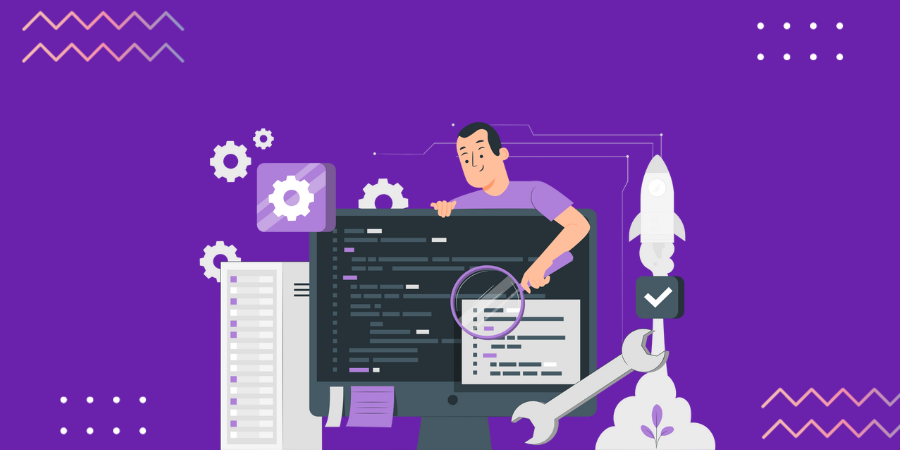
No-Code Development Platforms: Choosing the Right One…
The demand for speedy application development has never been greater i...
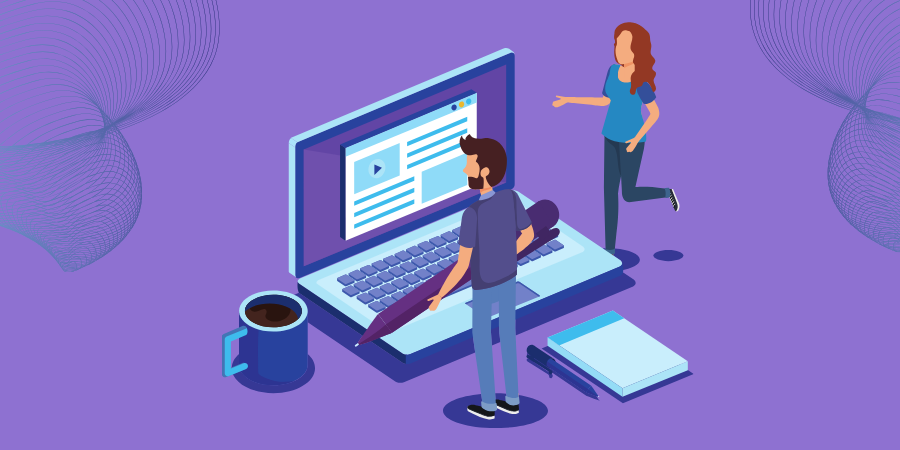
8 Mobile-Friendly Website Design Mistakes to Avoid
Nearly all of your competitors have websites that are not just exquisi...
Analyze your business's potential and look for prospects for growth.
- S.C.O. 44, Sector 110, Mohali, Punjab, 140307
- +91-16079-66783
- 5718 Westheimer Rd, Suite 1000, Houston, Texas, 77057
- +1-832-548-4526
Quick links
- How we work
- Testimonial
- Mobile App Development
- Web Development
- CMS Development
- Ecommerce Development
- Blockchain Development
Technologies
- PHP Development
- Python Development
- Android App Development
- IOS App Development
- Magento Development
- Shopify Development
- React Js Development
The 6 Best Apps to Improve Your Problem-Solving Skills
Want to improve your problem-solving skills and become more solution-oriented in your daily routine? Here are some apps to try.
Your ability to solve problems is a valuable skill you cannot do without if you want to succeed in your career, business, and life. While most people learn to solve problems primarily through exposure to challenging situations and having to find solutions almost immediately, others don't.
As such, not everyone is skilled at effective problem-solving. However, there is an easy way to improve your problem-solving skills using technology. Today, there are several fun ways to do so, including playing brain games on your mobile. Here are six game apps you can use to develop problem-solving skills while having fun.
1. Lumosity
Lumosity is a web app that helps you improve your mental skills. It is programmed with activities that help people improve their memory, flexibility, rate of processing information, and concentration levels. Thus, Lumosity is a great tool to help you develop problem-solving capabilities.
Lumosity was launched in 2007 and had over 70 million users as of January 2015. The app is available in English, French, Spanish, and German.
Download : Lumosity for Android | iOS (Free, in-app purchases available)
Happify is a company that works to enhance personal, organizational, and healthcare effectiveness by improving the emotional health of its users.
The Happify app incorporates scientific experiments into gaming activities designed to improve resilience and mindfulness and tackle health conditions like mood disorders, depression, anxiety, severe pain, and insomnia. Thus, it is a great healthcare software platform for improving your mental and physical conditions.
Download : Happify for Android | iOS (Free, in-app purchases available)
Launched by Elevate Labs in 2014, Elevate is a brain game app that focuses on improving its users' reading, writing, speaking, listening, and math skills. It is also one of the best android apps to help you solve math problems .
Seeing you already possess the skills mentioned above, you may wonder, is the Elevate brain training app worth your time ? The truth is, there is always room for improvement, hence, the need for you to keep developing these skills. And, as you pass each assessment in the training sessions, the difficulty level increases. This way, you can test whether your abilities are basic or strong.
Download : Elevate for Android | iOS (Free, in-app purchases available)
4. Neuronation
Neuronation is a cognitive training site and app that was made public in 2011. Since then, over 10 million people have used the app. The Neuronation app focuses on improving users' cognitive abilities, such as thinking, learning, understanding, and remembering, through its specialized training activities in the program.
Although native to Germany, the app is available in over eight languages, including English, French, Spanish, Italian, Portuguese, Russian, Turkish, and German. Additionally, the app enjoys widespread use, especially among German healthcare practitioners.
Download: Neuronation for Android | iOS (Free, in-app purchases available)
The Peak brain training app is designed to correct cognitive disorders with the help of short, interactive games. To get started on the Peak brain game app, you will be required to set goals on areas you want to improve, like mental processing, emotional strength, linguistic skills, recollection, concentration levels, and problem-solving.
Once you complete this stage, a virtual coach will be assigned to guide you through the program, and you will be given an assessment. Immediately after you finish each assessment, you will receive feedback based on your result.
You can start using the app for free with the basic version, but it has a limited number of daily exercises that are randomly selected. On the other hand, with the paid version, Peak Pro, you enjoy unlimited access to over 40+ exercises, alongside detailed feedback and personalized training sessions.
Download : Peak for Android | iOS (Free, in-app purchases available)
6. New York Times Crossword
The New York Times Crossword is a daily puzzle published by the renowned New York Times magazine on their website and mobile apps. The New York Times Crossword puzzle dates back to 1942. The first puzzle was published on Sunday, 15 February 1942.
Several freelance puzzle developers generate the puzzle. The puzzle gets tougher as each day goes by in a week, so the simplest puzzles are on Mondays, and the hardest are on Saturdays. Sunday's crossword puzzle is a 21×21 square matrix, whereas the daily crossword puzzle is a 15×15 square matrix. The crossword and other free puzzle games greatly improve critical thinking, learning, and reasoning abilities.
Download : New York Times Crossword for Android | iOS (Free, in-app purchases available)
Have Fun While Improving Your Problem-solving Skills
Developing cognitive abilities, emotional well-being, and problem-solving skills are no longer challenging. Thanks to these brain game apps, you can develop and improve your mental and emotional abilities more easily, faster, and while having fun.

- Search Search Search …
- Search Search …
Best Apps for Problem Solving: Top Picks for Effective Solutions

In today’s fast-paced and technology-driven world, problem-solving skills are becoming increasingly crucial for personal and professional success. It is important to recognize that problem-solving involves more than just finding answers to a problem; it’s about understanding the problem, identifying potential solutions, and making informed decisions. In this regard, problem-solving apps have the potential to drastically improve one’s abilities in a variety of areas, as well as provide educational benefits.
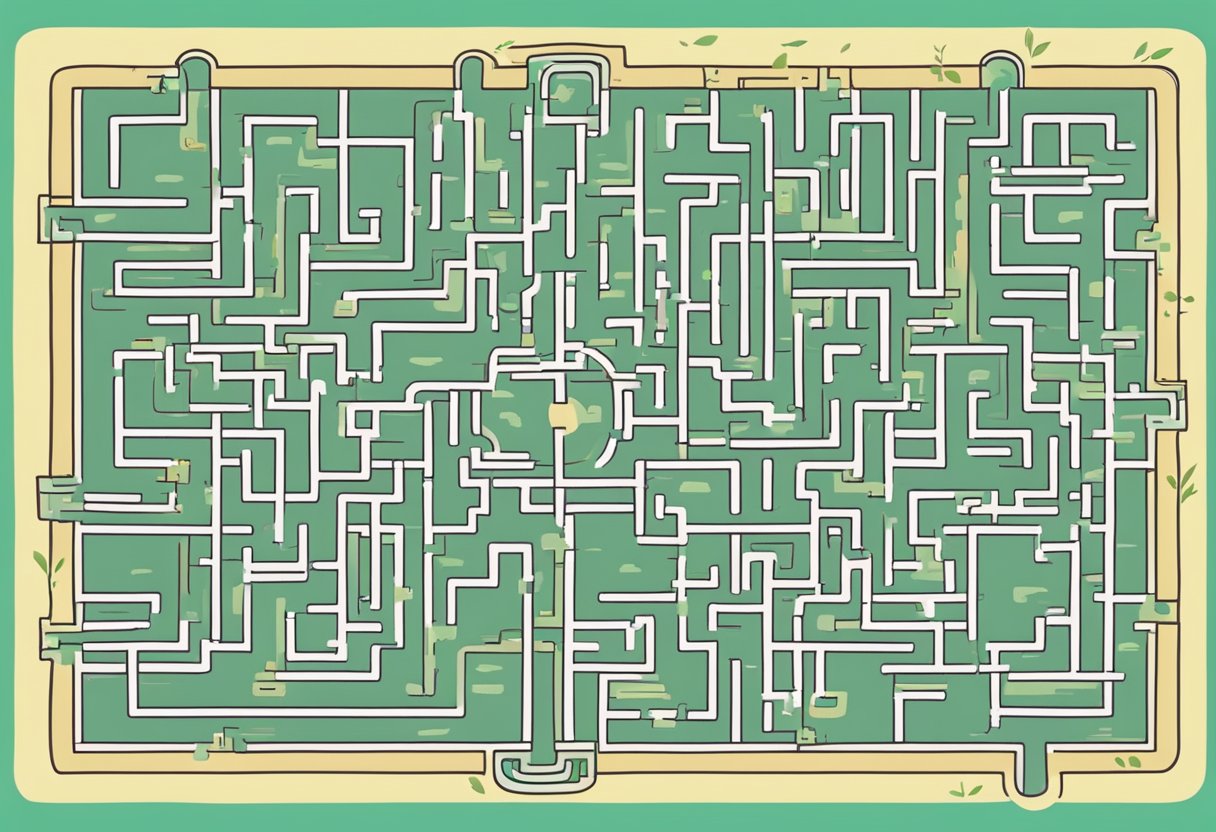
These apps come in many forms, addressing everything from math and science problems to enhancing attention and concentration. They offer accessibility and support for users seeking to bolster their problem-solving capabilities. In addition to educational applications, many of these apps are also tailored to address challenges in industries like business and mental health or even to provide career guidance.
Key Takeaways
- Problem-solving apps cover a wide range of topics and can improve both personal and professional success.
- Educational benefits are a significant aspect of these apps, as they deal with various subjects such as math, science, and concentration.
- Apps that provide support for problem-solving extend beyond education, addressing challenges in business, mental health, and career guidance.
Recognizing Problem-Solving Apps

Today’s technology landscape is filled with mobile apps that aim to address various challenges we face daily. Recognizing essential problem-solving apps for iOS and Android devices can significantly improve our efficiency and simplify our lives.
- Lumosity : This app is designed to improve mental skills with engaging activities that target memory, flexibility, information processing speed, and concentration levels. Lumosity is perfectly suitable for individuals looking to enhance their problem-solving capabilities.
- Braingle : Braingle stands out for its focus on mental sharpness and reasoning through riddles and visual illusions. Compared to other apps, Braingle offers a unique approach to problem-solving, instead of relying on memory and reaction-based tasks.
Android Apps
- Educurious : This website offers supplemental apps that aim to turn students into “developing experts” by connecting them with real-world mentors and providing problem-based learning activities.
- Photomath : An app that simplifies mathematical problem-solving, Photomath allows users to scan a math problem with their device’s camera and receive instant solutions, explanations, and step-by-step instructions on how to solve it.
By incorporating these problem-solving apps into daily routines, users can enhance their mental abilities and find solutions to everyday challenges more effectively. Focusing on the right technology and investing time in useful software will undoubtedly improve one’s overall problem-solving skills.
Educational Benefits of Problem-Solving Apps
Boosting learning skills.
Problem-solving apps provide a variety of educational benefits to users, aiding in the development of crucial learning skills. These apps target different aspects of learning, such as memory, reading, writing, and listening, by presenting engaging challenges and activities. As users navigate through these tasks, they gain valuable insights and ideas that contribute to their overall understanding of an array of subjects.
Incorporating elements such as Lumosity with a personalized approach to learning can offer tailored activities to improve memory, attention, speed, and problem-solving skills. This adaptability allows users to progress at their own pace while receiving appropriate guidance and support.
Enhancing Critical Thinking
Problem-solving apps also play a vital role in enhancing critical thinking abilities. By offering various challenges and exercises, these apps motivate users to employ creative thinking, logical reasoning, and decision-making skills. Through continuous practice and application, the users develop a deeper understanding of concepts and improve their ability to analyze and evaluate scenarios.
Moreover, apps like Educurious , which connects students with real-world mentors and incorporates the Common Core aligned curriculum, help students build their critical thinking abilities and problem-based learning skills in line with the 21st-century technology demands.
In conclusion, problem-solving apps offer numerous educational benefits, from boosting learning skills to enhancing critical thinking. As users engage with these apps, they become more confident in their learning abilities, paving the way for higher academic achievement and lifelong learning.
Applications in Math and Science
In this digital age, there are numerous apps and websites available to help students develop problem-solving skills in math and science. These resources provide interactive, engaging, and adaptive platforms to enhance their educational experience.
Apps for Math Problems
From basic calculations to more complex topics like algebra, calculus, and word problems, math apps offer an excellent way to empower students with the tools they need for success.
One such resource is Mathway , which caters to a wide range of mathematical topics. Mathway enables students to input math problems, offering step-by-step solutions and explanations to further their understanding. The app even has a graphing feature for visual learners.
Another engaging resource is Moose Math , a free app that focuses on math games. These games assist younger students in refining their math skills, such as counting, addition, and subtraction, through points earned for completing challenges.
Applications for Science Tasks
When it comes to science, students need a comprehensive understanding of various concepts across physics, chemistry, and biology. Several apps can help with this intricate learning process.
For common core science concepts, Brilliant offers hands-on, interactive lessons to build quantitative skills. This platform covers core topics like algebra functions, quadratics, and even computer science concepts. Brilliant is designed to help students dive deep into problem-solving by breaking down complex topics and providing in-depth examples.
To assist students with their science homework, websites like Educators Technology can offer a selection of math problem solver apps. These apps not only tackle math problems but also provide additional reinforcement for understanding scientific concepts.
In conclusion, utilizing these various apps and online tools can significantly improve students’ problem-solving abilities in both math and science domains, paving the way for academic success.
Enhancing Attention and Concentration
A critical aspect of improving problem-solving skills involves enhancing one’s attention and concentration. Numerous apps are designed to target these cognitive abilities, allowing individuals to perform tasks efficiently and manage their time effectively.
One popular app that aims to maximize attention span is Lumosity . Developed by a team of game designers and scientists, Lumosity offers a range of interactive games and training exercises. These games are specifically tailored to improve memory, processing speed, attention span, and overall cognitive ability. By engaging in these activities regularly, users can strengthen their focus and address their weaknesses.
In addition to Lumosity, other apps are well-regarded for their positive influence on attention and concentration. For instance, Calm Sage lists several brain training apps to help improve memory and cognitive function. These apps provide fun, challenging exercises that test users’ problem-solving skills and logical thinking abilities while also identifying areas of improvement. Engaging in these activities can foster perseverance, allowing individuals to tackle tasks with greater determination and success.
To ensure that users can effectively manage their time, it is essential to incorporate strategies that promote enhanced attention and concentration. By utilizing apps like Lumosity and those mentioned on Calm Sage, individuals can train their brains to focus on tasks more effectively and allocate their time more efficiently. Ultimately, these tools can lead to meaningful improvements in one’s ability to approach complex problem-solving scenarios with confidence and clarity.
Support and Help within Apps
When it comes to problem-solving apps, efficient support and help features are crucial for users to navigate through the platform and find the solutions they need. A good app will provide diverse support mechanisms, whether it’s tutorials for first-time users, FAQs to answer common questions, or customer service to address specific concerns.
In-app purchases often play a significant part in enhancing app experience. They might offer advanced features or additional resources, allowing users to unlock their full potential when solving problems. However, it’s essential for the app developers to offer a clear and transparent payment system, helping users to make informed decisions on whether the additional content is worth the investment.
Problem-solving apps rely on user reviews and feedback to constantly improve their features and functionalities. Therefore, it’s essential to have an efficient way for users to communicate their experiences, suggestions, and issues. Developers should ensure that they actively monitor feedback and provide prompt responses to users who might need assistance with the app.
When it comes to navigating through an app, a well-designed interface and smooth user experience will keep users engaged and motivated to solve problems. This includes logical menu structures, consistent design elements, and clear labeling for different sections or features. Visual aids, such as color-coding or iconography, can further help users find their way around the app, streamlining the overall problem-solving process.
By addressing these aspects, problem-solving apps can create a holistic experience with clear solutions and support mechanisms in place. When users feel empowered to access the help they need, it enables them to tackle challenges effectively, enhancing their overall problem-solving experience.
Problem-Solving Apps for Business
Applications for business challenges.
In today’s fast-paced business environment, companies face various challenges, such as improving customer service, addressing operational inefficiencies, and managing resources effectively. With the help of innovative mobile apps, businesses can tackle these issues and find effective solutions.
Lumosity is a prime example of a problem-solving app designed to improve mental skills. By enhancing memory, flexibility, and information processing speed, this web app can indirectly contribute to the development of employees’ problem-solving capabilities.
Mobile applications are becoming increasingly useful in improving customer services by providing quicker query resolution and 24/7 support. AI-based chatbots, often embedded in mobile apps, can help businesses respond to customer queries and questions more efficiently, resulting in better customer satisfaction.
In addressing business operations , many organizations turn to Microsoft Power Apps to identify and solve problems. Power Apps allow developing custom applications tailored to specific business needs without requiring extensive coding experience. By streamlining processes and automating manual tasks, these apps can significantly impact operational efficiency.
Furthermore, numerous apps on the market solve everyday problems faced by both businesses and individuals. For example, Google Play offers 2.56 million mobile apps, while the App Store provides access to 1.85 million apps. Among these vast selections, businesses can surely find applications that cater to their specific requirements, from project management to financial planning.
In summary, as businesses traverse the ever-evolving landscape of challenges, adopting problem-solving applications can undoubtedly provide valuable assistance in finding the most effective and efficient solutions along their path to success.
Mental Health Support through Apps
In today’s fast-paced world, finding support and solutions for mental health issues is crucial. Numerous apps have been developed to help individuals cope with and manage their anxiety and depression. These digital tools offer a variety of approaches to maintaining mental well-being, from cognitive training exercises to resources for professional guidance.
Apps for Anxiety
Anxiety can manifest in different ways, but common symptoms include constant worrying, restlessness, and even physical symptoms like rapid heartbeat or shortness of breath. The following apps aim to provide support and techniques for managing anxiety:
- Headspace : This popular meditation app teaches mindfulness techniques, which have been found effective in managing anxiety and reducing instances of negative, repetitive thinking.
- MindShift : Designed specifically for anxiety, MindShift provides resources and tools to help users develop healthy coping strategies and face their fears. This app embraces Cognitive Behavioral Therapy (CBT) principles, which are widely considered as an effective approach to dealing with anxiety disorders.
Apps for Depression
Depression can be a debilitating condition resulting in persistent sadness, loss of interest in daily activities, and even physical symptoms like lack of energy or changes in appetite. The following apps offer support and solutions for those experiencing depression:
- Lumosity : This brain-training app focuses on cognitive exercises that stimulate different areas of the brain and encourage users to develop healthy cognitive habits. By improving memory, attention, and problem-solving skills, Lumosity can help individuals coping with depression maintain their mental abilities and gain a stronger sense of control.
- Elevate : Like Lumosity, Elevate is a cognitive training app aimed at improving focus, memory, and comprehension through engaging games and activities. Regular use of the app can lead to better mental clarity, which may help alleviate some depressive symptoms.
- BetterHelp : This platform connects users with licensed therapists, offering a convenient way to access professional mental health support. BetterHelp provides therapy sessions through phone, video, or messaging, making it easier for those experiencing depression to receive the guidance they need.
Using apps for mental health support can be an effective and accessible way to manage anxiety and depression. It is important, however, to remember that these apps are not a substitute for professional help but can serve as valuable supplementary tools in one’s mental health journey.
Popular Puzzle and Brain Games
Memory-boosting puzzle games.
A variety of memory-boosting puzzle games are available for those who wish to sharpen their cognitive skills. These games are designed to challenge the brain and improve memory, logic, and problem-solving abilities. Some popular memory-boosting puzzle games include:
- Lumosity : This app offers over 40 puzzles and games that test your brain and help train memory, logic, and math skills for a well-rounded mind workout. It features specific challenges for attention, flexibility, problem solving, language, math, speed, memory, and more ( source ).
- Grindstone : A strategy puzzle game where players plan each move carefully to complete levels efficiently, thus encouraging the development of critical thinking and planning skills ( source ).
- Monument Valley : This beautiful and captivating game requires players to manipulate the environment to progress through an M.C. Escher-inspired world, enhancing spatial reasoning and creativity.
The New York Times Crossword
The New York Times Crossword is a classic app that has stood the test of time, providing avid fans with daily crossword puzzles to stimulate their brains and expand their vocabularies. The puzzles range in difficulty, offering varying levels of challenge for both new and experienced solvers. The app is easily accessible on both Android and iOS devices, enabling players to indulge in a moment of problem-solving fun anytime and anywhere.
By engaging in these popular puzzle and brain games, players can keep their minds sharp and refine their problem-solving skills. These activities not only provide a fun and engaging form of entertainment but also promote cognitive growth and development.
Career Guidance through Problem-Solving Apps
In today’s competitive job market, individuals seeking career success must continually hone their problem-solving skills. By utilizing problem-solving apps, they can sharpen their cognitive abilities, find solutions to challenges, and stay on the right path to achievement. In this section, we will discuss some of the best apps that are designed to help improve problem-solving skills.
Braingle is a unique app that pushes the limits of mental sharpness through the use of riddles and visual illusions. By presenting different types of puzzles, Braingle encourages users to strengthen their reasoning and analytical skills, which could be beneficial in various aspects of career growth.
Another outstanding app is Lumosity , specifically designed to enhance cognitive function. It offers various activities that focus on memory, flexibility, information processing speed, and concentration. Incorporating Lumosity into one’s routine can ultimately lead to better problem-solving capabilities necessary for career advancement.
The third app, Elevate , is an award-winning brain training program offering a wide array of exercises and games. These activities are aimed at improving cognitive abilities critical for effective problem-solving. With a progress tracking feature, users can monitor their improvement over time and see how they are progressing in their problem-solving skills.
In addition to these apps, individuals must also practice problem-solving strategies in the workplace. Asana recommends a four-step approach, starting with identifying the problem, gathering information, formulating a plan, and executing the solution. Following this process can efficiently solve issues faced in a professional environment.
By using these problem-solving apps and adopting a methodical approach to tackling career challenges, individuals can pave the way for continuous growth and achievement. It is vital to remember that enhancing one’s problem-solving skills is a journey, requiring dedication and persistent effort.
You may also like

The Basics of Using Critical Thinking in Business
In the world of business, being precise and careful is highly recommended. However, how often do you respond too rashly to a […]

Best Approach to Problem Solving: Efficient Strategies for Success
Problem-solving is a crucial skill in all aspects of life, from personal interactions to navigating complex work situations. It is essential for […]

How to Demonstrate Critical Thinking
We live in the Information age—barraged by news and other content, and surrounded by information sources such as online archives, ebooks, webinars, […]

Examples of Critical Thinking in Everyday
Most people think of high academia when they hear the phrase “critical thinking.” They have a natural tendency to associate it with […]
This is where the search bar goes
The Real Problem with Software Development
It’s not writing code, it’s managing complexity

A few weeks ago, I saw a tweet that said “Writing code isn’t the problem. Controlling complexity is.” I wish I could remember who said that; I will be quoting it a lot in the future. That statement nicely summarizes what makes software development difficult. It’s not just memorizing the syntactic details of some programming language, or the many functions in some API, but understanding and managing the complexity of the problem you’re trying to solve.
We’ve all seen this many times. Lots of applications and tools start simple. They do 80% of the job well, maybe 90%. But that isn’t quite enough. Version 1.1 gets a few more features, more creep into version 1.2, and by the time you get to 3.0, an elegant user interface has turned into a mess. This increase in complexity is one reason that applications tend to become less useable over time. We also see this phenomenon as one application replaces another. RCS was useful, but didn’t do everything we needed it to; SVN was better; Git does just about everything you could want, but at an enormous cost in complexity. (Could Git’s complexity be managed better? I’m not the one to say.) OS X, which used to trumpet “It just works,” has evolved to “it used to just work”; the most user-centric Unix-like system ever built now staggers under the load of new and poorly thought-out features.

Learn faster. Dig deeper. See farther.
Join the O'Reilly online learning platform. Get a free trial today and find answers on the fly, or master something new and useful.
The problem of complexity isn’t limited to user interfaces; that may be the least important (though most visible) aspect of the problem. Anyone who works in programming has seen the source code for some project evolve from something short, sweet, and clean to a seething mass of bits. (These days, it’s often a seething mass of distributed bits.) Some of that evolution is driven by an increasingly complex world that requires attention to secure programming, cloud deployment, and other issues that didn’t exist a few decades ago. But even here: a requirement like security tends to make code more complex—but complexity itself hides security issues. Saying “yes, adding security made the code more complex” is wrong on several fronts. Security that’s added as an afterthought almost always fails. Designing security in from the start almost always leads to a simpler result than bolting security on as an afterthought, and the complexity will stay manageable if new features and security grow together. If we’re serious about complexity, the complexity of building secure systems needs to be managed and controlled in step with the rest of the software, otherwise it’s going to add more vulnerabilities.
That brings me to my main point. We’re seeing more code that’s written (at least in first draft) by generative AI tools, such as GitHub Copilot, ChatGPT (especially with Code Interpreter), and Google Codey. One advantage of computers, of course, is that they don’t care about complexity. But that advantage is also a significant disadvantage. Until AI systems can generate code as reliably as our current generation of compilers, humans will need to understand—and debug—the code they write. Brian Kernighan wrote that “Everyone knows that debugging is twice as hard as writing a program in the first place. So if you’re as clever as you can be when you write it, how will you ever debug it?” We don’t want a future that consists of code too clever to be debugged by humans—at least not until the AIs are ready to do that debugging for us. Really brilliant programmers write code that finds a way out of the complexity: code that may be a little longer, a little clearer, a little less clever so that someone can understand it later. (Copilot running in VSCode has a button that simplifies code, but its capabilities are limited.)
Furthermore, when we’re considering complexity, we’re not just talking about individual lines of code and individual functions or methods. Most professional programmers work on large systems that can consist of thousands of functions and millions of lines of code. That code may take the form of dozens of microservices running as asynchronous processes and communicating over a network. What is the overall structure, the overall architecture, of these programs? How are they kept simple and manageable? How do you think about complexity when writing or maintaining software that may outlive its developers? Millions of lines of legacy code going back as far as the 1960s and 1970s are still in use, much of it written in languages that are no longer popular. How do we control complexity when working with these?
Humans don’t manage this kind of complexity well, but that doesn’t mean we can check out and forget about it. Over the years, we’ve gradually gotten better at managing complexity. Software architecture is a distinct specialty that has only become more important over time. It’s growing more important as systems grow larger and more complex, as we rely on them to automate more tasks, and as those systems need to scale to dimensions that were almost unimaginable a few decades ago. Reducing the complexity of modern software systems is a problem that humans can solve—and I haven’t yet seen evidence that generative AI can. Strictly speaking, that’s not a question that can even be asked yet. Claude 2 has a maximum context—the upper limit on the amount of text it can consider at one time—of 100,000 tokens 1 ; at this time, all other large language models are significantly smaller. While 100,000 tokens is huge, it’s much smaller than the source code for even a moderately sized piece of enterprise software. And while you don’t have to understand every line of code to do a high-level design for a software system, you do have to manage a lot of information: specifications, user stories, protocols, constraints, legacies and much more. Is a language model up to that?
Could we even describe the goal of “managing complexity” in a prompt? A few years ago, many developers thought that minimizing “lines of code” was the key to simplification—and it would be easy to tell ChatGPT to solve a problem in as few lines of code as possible. But that’s not really how the world works, not now, and not back in 2007. Minimizing lines of code sometimes leads to simplicity, but just as often leads to complex incantations that pack multiple ideas onto the same line, often relying on undocumented side effects. That’s not how to manage complexity. Mantras like DRY (Don’t Repeat Yourself) are often useful (as is most of the advice in The Pragmatic Programmer ), but I’ve made the mistake of writing code that was overly complex to eliminate one of two very similar functions. Less repetition, but the result was more complex and harder to understand. Lines of code are easy to count, but if that’s your only metric, you will lose track of qualities like readability that may be more important. Any engineer knows that design is all about tradeoffs—in this case, trading off repetition against complexity—but difficult as these tradeoffs may be for humans, it isn’t clear to me that generative AI can make them any better, if at all.
I’m not arguing that generative AI doesn’t have a role in software development. It certainly does. Tools that can write code are certainly useful: they save us looking up the details of library functions in reference manuals, they save us from remembering the syntactic details of the less commonly used abstractions in our favorite programming languages. As long as we don’t let our own mental muscles decay, we’ll be ahead. I am arguing that we can’t get so tied up in automatic code generation that we forget about controlling complexity. Large language models don’t help with that now, though they might in the future. If they free us to spend more time understanding and solving the higher-level problems of complexity, though, that will be a significant gain.
Will the day come when a large language model will be able to write a million line enterprise program? Probably. But someone will have to write the prompt telling it what to do. And that person will be faced with the problem that has characterized programming from the start: understanding complexity, knowing where it’s unavoidable, and controlling it.
- It’s common to say that a token is approximately ⅘ of a word. It’s not clear how that applies to source code, though. It’s also common to say that 100,000 words is the size of a novel, but that’s only true for rather short novels.
Get the O’Reilly Radar Trends to Watch newsletter
Tracking need-to-know trends at the intersection of business and technology.
Please read our privacy policy .
Thank you for subscribing.
Help | Advanced Search
Computer Science > Computation and Language
Title: chatglm-math: improving math problem-solving in large language models with a self-critique pipeline.
Abstract: Large language models (LLMs) have shown excellent mastering of human language, but still struggle in real-world applications that require mathematical problem-solving. While many strategies and datasets to enhance LLMs' mathematics are developed, it remains a challenge to simultaneously maintain and improve both language and mathematical capabilities in deployed LLM this http URL this work, we tailor the Self-Critique pipeline, which addresses the challenge in the feedback learning stage of LLM alignment. We first train a general Math-Critique model from the LLM itself to provide feedback signals. Then, we sequentially employ rejective fine-tuning and direct preference optimization over the LLM's own generations for data collection. Based on ChatGLM3-32B, we conduct a series of experiments on both academic and our newly created challenging dataset, MathUserEval. Results show that our pipeline significantly enhances the LLM's mathematical problem-solving while still improving its language ability, outperforming LLMs that could be two times larger. Related techniques have been deployed to ChatGLM\footnote{\url{ this https URL }}, an online serving LLM. Related evaluation dataset and scripts are released at \url{ this https URL }.
Submission history
Access paper:.
- HTML (experimental)
- Other Formats
References & Citations
- Google Scholar
- Semantic Scholar
BibTeX formatted citation
Bibliographic and Citation Tools
Code, data and media associated with this article, recommenders and search tools.
- Institution
arXivLabs: experimental projects with community collaborators
arXivLabs is a framework that allows collaborators to develop and share new arXiv features directly on our website.
Both individuals and organizations that work with arXivLabs have embraced and accepted our values of openness, community, excellence, and user data privacy. arXiv is committed to these values and only works with partners that adhere to them.
Have an idea for a project that will add value for arXiv's community? Learn more about arXivLabs .
ORIGINAL RESEARCH article
Integrating inquiry and mathematical modeling when teaching a common topic in lower secondary school: an istem approach provisionally accepted.

- 1 Hong Kong Baptist University, Hong Kong, SAR China
The final, formatted version of the article will be published soon.
The world has been increasingly shaped by Science, Technology, Engineering and Mathematics (STEM). This has resulted in educational systems across the globe implementing STEM education. To reap maximum benefits, researchers are now advocating for the integration of STEM domains. In recent studies, the integration of science and mathematics has become increasingly popular. The domains are much more suitable for integration because of their fields of application and their mutual approach towards problem-solving. However, there is little empirical evidence to drive the development of a practical model for classroom implementation. This study aims to cover that gap through integrating mathematics and science concepts when teaching a common topic to two classes of Form 1 (13-14 years) students. A mathematics and a science teacher went through two cycles of lesson study, integrating and teaching the concept of density. Results show a strong synergy between the BSCS 5E instructional model of inquiry and mathematical modeling; hence the methodological approaches can be used to integrate common topics like density. Further, teacher collaboration, teacher immersion in the iSTEM practices, teacher's knowledge, and skills of the other subject and an in-depth understanding of a problem and its contextualization, are variables that can be capitalized on to enhance the teacher's capacity to implement innovative and integrated STEM programs effectively.
Keywords: iSTEM1, Inquiry2, mathematical modeling3, Integration model4, Science5. Mathematics6, Density7
Received: 26 Jan 2024; Accepted: 10 Apr 2024.
Copyright: © 2024 Manunure and Leung. This is an open-access article distributed under the terms of the Creative Commons Attribution License (CC BY) . The use, distribution or reproduction in other forums is permitted, provided the original author(s) or licensor are credited and that the original publication in this journal is cited, in accordance with accepted academic practice. No use, distribution or reproduction is permitted which does not comply with these terms.
* Correspondence: Mr. Kevin Manunure, Hong Kong Baptist University, Kowloon, Hong Kong, SAR China
People also looked at

IMAGES
VIDEO
COMMENTS
Problem-solving is a vital skill for any mobile app developer. By following these steps and using these tools and techniques, you can improve your problem-solving skills and become a more ...
It's even better if the members of the team are used to swim in uncertainty, and take it as a challenge more than a chore. The process described above is just an example; in practice it's often more chaotic. For example, even when a decision is made, your brain might still continue to process the problem passively.
To train the problem-solving side of your brain, these four tips and strategies can help you improve your abilities: 1. Make problem-solving a part of your life. Never restrict yourself to working on problems only during work hours. Don't make it a chore, but, instead, do things that make problem-solving look fun.
Still, securing a mobile app is a lot more complicated than many other processes involved in app development. Developers need to protect the app from malware, bugs and prevent other vulnerabilities. As such, they can solve security problems by encrypting the app's communication with its server.
The takeaway. Good problem-solving skills combine various skills, experiences, mindset schemes, personality traits, and interests. Problem-solving skills are an irreplaceable asset to have, both professionally and personally. And truth be told, all great devs have outstanding problem-solving skills. But one thing is certain, for mastering ...
11 Key Mobile App Development Challenges in 2024. To build an app that is both high-performing and resource-efficient, focus on choosing algorithms with low time and space complexity. Implementing database indexing and batch transactions can also speed up data retrieval, providing a smoother user experience. For an app to work seamlessly both ...
App development is the process of building applications for use on various operating systems through the use of one or more programming languages. ... It is the tech industry's definitive destination for sharing compelling, first-person accounts of problem-solving on the road to innovation. Learn More. Great Companies Need Great People. That ...
2. Omnex Systems. via Omnex. Omnex's problem-solving software has many helpful features to track, manage, and solve problems quickly. It's a one-stop shop for dealing with internal and external issues. The platform is also customer-centric, which responds to customers in their preferred formats.
12 Ways to Come Up with New Mobile App Ideas . 1. Start by solving your problems. Start coming up with app ideas by identifying the frustrations that you have with the current way of doing things. Look at these problems, research and try to find apps that solve your actual or similar problems.
Finding a suitable solution for issues can be accomplished by following the basic four-step problem-solving process and methodology outlined below. Step. Characteristics. 1. Define the problem. Differentiate fact from opinion. Specify underlying causes. Consult each faction involved for information. State the problem specifically.
1: App Store Optimization (ASO) ASO is the process of making your app rank at the top of relevant search results on the respective app stores. This is the best way to get downloads. When people search for solutions to certain problems, e.g. "Pet Food Delivery," your app should be what they see first.
Developers are discovering ways to amplify their creativity and problem-solving capabilities through AI collaboration. This exploration of the evolving landscape of AI in app development serves as a foundational understanding of the transformative shifts that are shaping the future of app creation and usage.
1. MedConnect. When it comes to patient care and communication with medical professionals, the MedConnect app has the potential to completely transform the healthcare system. This impactful app idea was created to give ease to patients, doctors, and hospitals to communicate and collaborate in real-time.
Innovation and entrepreneurship: Developing problem-solving apps requires creativity, innovation, and entrepreneurial spirit. By encouraging app development, we foster a culture of innovation and ...
Here are six game apps you can use to develop problem-solving skills while having fun. 1. Lumosity. Lumosity is a web app that helps you improve your mental skills. It is programmed with activities that help people improve their memory, flexibility, rate of processing information, and concentration levels. Thus, Lumosity is a great tool to help ...
Educational Benefits of Problem-Solving Apps Boosting Learning Skills. Problem-solving apps provide a variety of educational benefits to users, aiding in the development of crucial learning skills. These apps target different aspects of learning, such as memory, reading, writing, and listening, by presenting engaging challenges and activities.
Reducing the complexity of modern software systems is a problem that humans can solve—and I haven't yet seen evidence that generative AI can. Strictly speaking, that's not a question that can even be asked yet. Claude 2 has a maximum context—the upper limit on the amount of text it can consider at one time—of 100,000 tokens 1; at this ...
Software engineers design and create computer systems and applications to solve real-world problems. Software engineers, also called software developers, create software for computers and applications. If you're an analytical thinker who enjoys solving problems and making digital products easier, a career as a software engineer may be rewarding.
Large language models (LLMs) have shown excellent mastering of human language, but still struggle in real-world applications that require mathematical problem-solving. While many strategies and datasets to enhance LLMs' mathematics are developed, it remains a challenge to simultaneously maintain and improve both language and mathematical capabilities in deployed LLM systems.In this work, we ...
The domains are much more suitable for integration because of their fields of application and their mutual approach towards problem-solving. However, there is little empirical evidence to drive the development of a practical model for classroom implementation. This study aims to cover that gap through integrating mathematics and science ...